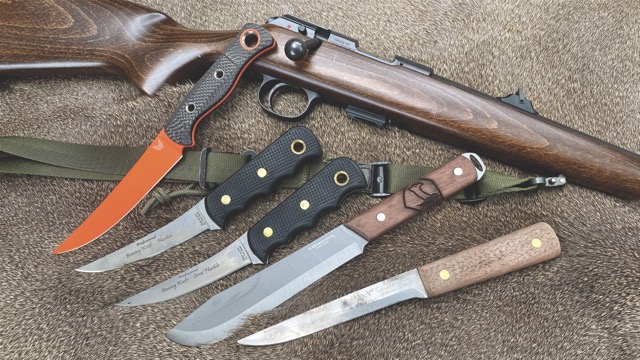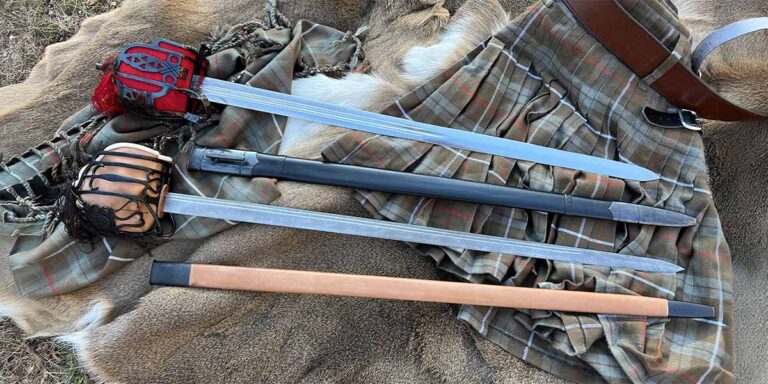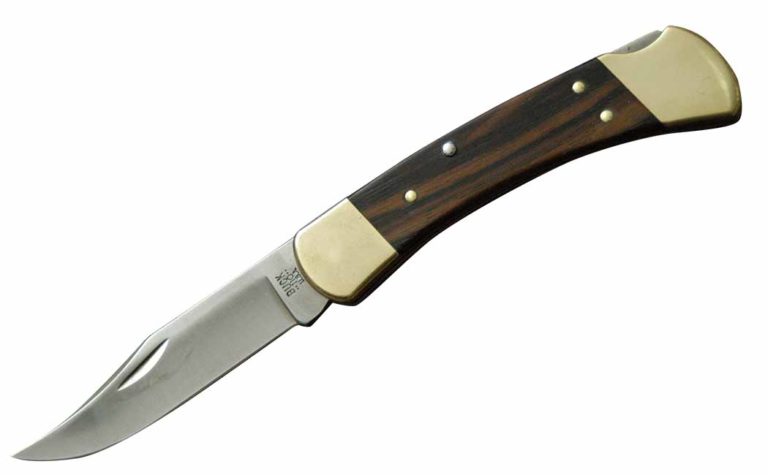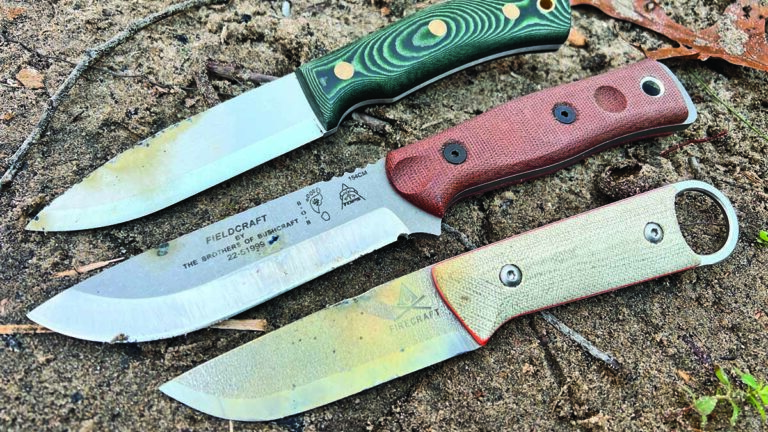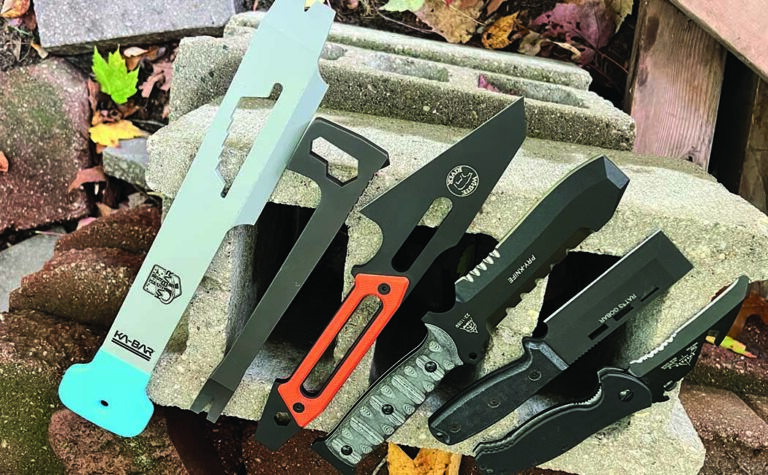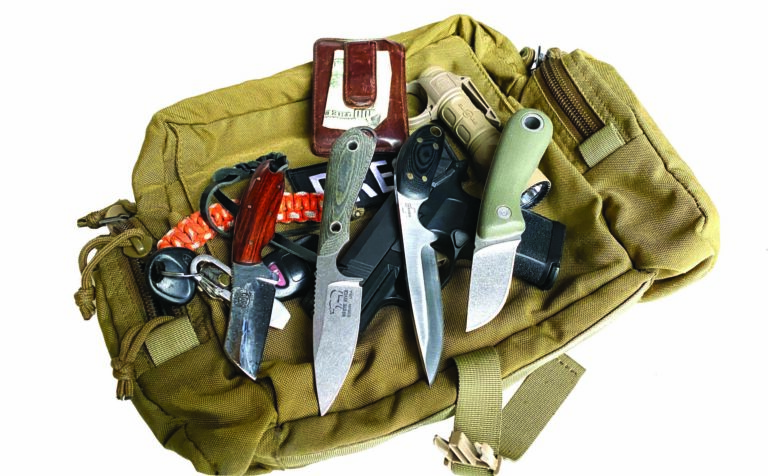Editor’s note: The author (Josh Wayner) spent the better part of five years working in a high-end specialty butcher shop in coastal west Michigan. That shop is no longer in business, though what he learned there has stayed with him and, as he noted, is very dear to his heart. We thought him to be the ideal writer to do a story on five of today’s factory boning knives. We think you will agree.
A former butcher’s mate gives boning knives the full test treatment to find the best boning knife.
I hunt deer and other large game regularly and own all my own professional processing equipment. Among these items is the most basic and essential tool: the boning knife. As a butcher’s mate and now as a full-time outdoor writer, I have some opinions on these blades and how to best use them.
A boning knife is a rather specialized tool, and getting the right shape for removing meat from bone is the name of the game. In my span hunting I’ve either shot or helped process hundreds of deer. I hunt the most game-rich areas in Michigan, and it’s common for my party to land a dozen deer in a night. The best knife for working on a deer is a 5-to-7-inch saber-ground blade of a steel about 3/16 inch thick that features an ample, comfortable handle.
The knife you absolutely do not want is a boning knife for this type of work. In my experience, a boning knife is for kitchen work, though I favor it as a primary knife for game under 50 pounds live weight.
The reason I offer here is that I’ve never seen an injury with a proper large-format field knife. Where I have seen horrible injuries is with thin-bladed knives like those in this article. They have the sickening tendency to snap off when going through sternums and joints; the flexibility has a limit and I’ve personally witnessed a dozen snapped blades, with half of the snaps resulting in a serious hand injury. Extreme care must be taken with ultra-thin, razor-sharp blades. In the process of creating this article, my friend who helped me process the deer meat in the photos was cut to the bone himself with an errant flick of the blade.
Best Boning Knives
- Best Dedicated Boning Knife: The Knives of Alaska (KoA) Professional Boning Knives
- Kitchen Functional Boning Knife: Ontario 72-6
- General Use Boning Knife: Condor Tool & Knife Butcher Knife
- Scalpel Sharp Boning Knife: Benchmade Meatcrafter
Best Boning Knives Specs Comparison
| Knife | Blade Length (inches) | Blade Material | Handle Material | Weight (ounces) | Overall Length (inches) | Sheath | Country of Origin | MSRP |
|---|---|---|---|---|---|---|---|---|
| Ontario 72-6 | 6.25 | 1095 spring | Hardwood | 4.8 | 10.75 | N/A | USA | $15 |
| Condor Tool & Knife Butcher Knife | 7 | 1075 carbon steel | Walnut | 5.3 | 12 | N/A | El Salvador | $38 |
| Benchmade Meatcrafter | 6.08 | CPM S45VN stainless | Carbon fiber | 4.52 | 11.06 | Black and orange polymer | USA | $400 |
| Knives of Alaska (KoA) Professional Boning Knives | 5 | D2 tool steel | Hard rubber | 4.2 | 9.625 | Black Kydex | USA | $50 |
Best Dedicated Boning Knife: Knives of Alaska Professional Boning Knife
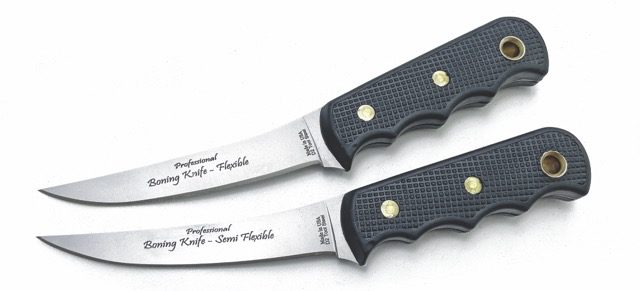
Pros
- Designed For The Job
- Ergonomic Handle
- Great Value for Performance
Cons
- Limited Versatility
KNIVES OF ALASKA PROFESSIONAL BONING KNIFE
BLADE LENGTH: 5″
BLADE MATERIAL: D2 tool steel
HANDLE MATERIAL: Hard rubber
SPECIAL FEATURES: Available in two different flexes: flexible and semi-flexible
WEIGHT: 4.2 ozs.
OVERALL LENGTH: 9.625″
SHEATH: Black Kydex
COUNTRY OF ORIGIN: USA
MSRP: $49.99
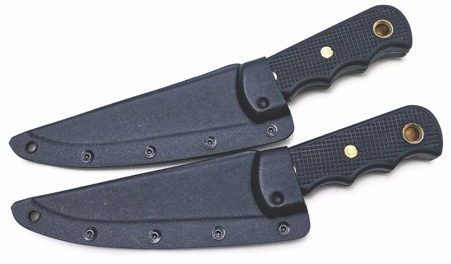
The Knives of Alaska (KoA) Professional Boning Knives—I tested both flexibility models—are exactly as their name implies. They are a bit more of an investment at about $50 each. They are however, inexpensive enough that they can be easily replaced if broken or lost in the field. These are truer dedicated boning knives and display a curved, upward-swept profile that forces the whole edge into use. The handle angle promotes a full grip while working on both meat on the bone and on a flat prep surface such as a cutting board.
These knives are superior to the first two reviewed in this story. They have an extremely fine point that gets into the bone and allows you to clean off nearly every meat bit. For the price, they are eminently functional and require minimal maintenance. They are my choice out of the bunch. They are an exact fit for their role, while not pretending to be something else. I like that the KoAs felt the closest to what I had in the butcher shop all those years ago.
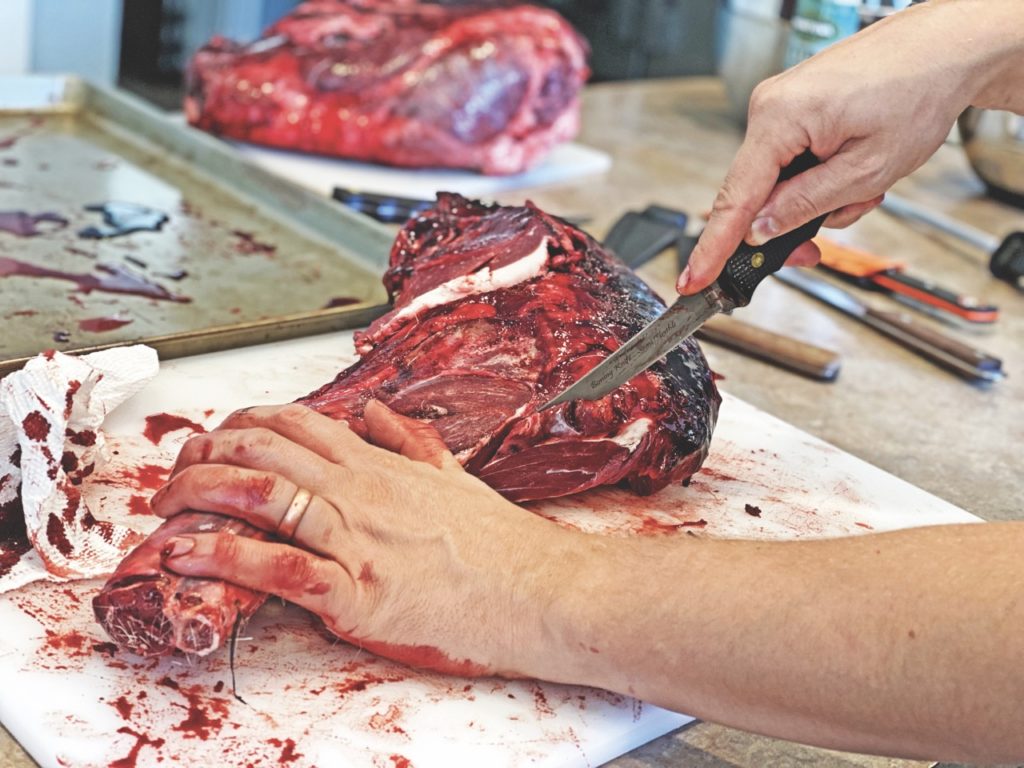
Kitchen Functional Boning Knife: Ontario 72-6

Pros
- Affordable
- Durable Edge
- Effective Breaking Down Large Cuts
Cons
- Corrosion-Prone Steel
- Unsealed Handle
ONTARIO OLD HICKORY 72-6 BONING KNIFE
BLADE LENGTH: 6.25″
BLADE MATERIAL: 1095 spring
HANDLE MATERIAL: Hardwood
SPECIAL FEATURES: Inexpensive and available in bulk quantities for rants and kitchens
WEIGHT: 4.8 ozs.
OVERALL LENGTH: 10.75″
COUNTRY OF ORIGIN: USA
MSRP: $14.99
Boning knives are a relatively distinctive category in that they span the range from essentially disposable to extremely high-end, yet are intended for the same purpose. Looking at the four in this article, the least expensive is the Ontario 72-6, which is available in bulk quantities and can be had for as little as $8. It is a good cutter, and excellent for breaking down large meat sections. The straight edge is less ideal for getting into ridges in the shoulder bone, but it is serviceable. In the case of this knife, the steel is very prone to corrosion and the handle is likewise unsealed or treated. To fight the corrosion, wash and dry the knife thoroughly after each use. Apply a light coat of oil on the blade on occasion as well.
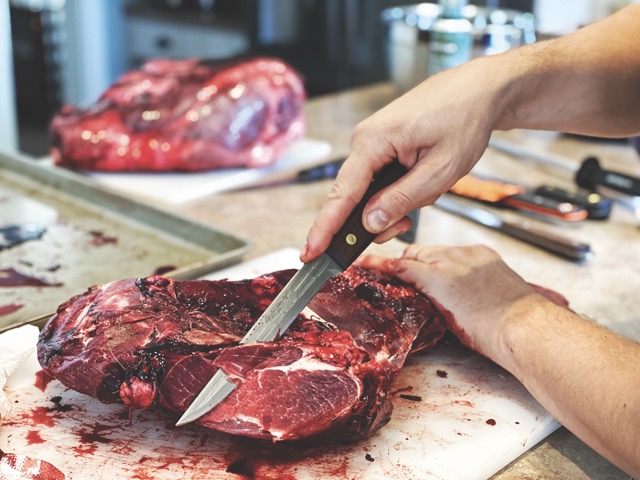
The ‘Old Hickory’ lettering on the handle came off after I washed the knife, and the steel began to spot immediately. This knife has a somewhat textured blade and is not smooth and even. Fat and blood can easily build up on the blade flats. That said, the edge out of the package was sharp, if not a little obtuse in terms of geometry. Despite my best efforts to dull it in use, it stayed sharp and functional. It has no guard or projection and is similar to a puukko in terms of the care that must be taken to not allow the hand to slip up and onto the blade. My impression of this blade is that it is a functional but essentially disposable kitchen tool.
General Use Boning Knife: Condor Tool & Knife Butcher Knife

Pros
- Sharp And Durable Edge
- Effective For Large Cuts
- Durable Construction
Cons
- Handle Logo Fouls
- Uneven Edge Usage
CONDOR TOOL G KNIFE BUTCHER KNIFE
BLADE LENGTH: 7″
BLADEMATERIAL: 1075 carbon steel
HANDLE MATERIAL: Walnut
SPECIAL FEATURES: Thin, light and practical for kitchen tasks
WEIGHT: 5.3 ozs.
OVERALL LENGTH: 12″
COUNTRY OF ORIGIN: El Salvador
MSRP: $37.78
The Condor Tool & Knife Butcher Knife has a similar handle to the 72-6, but the blade is longer and wider. The edge out of the box was sharp and held up. An immediate point of concern for sanitary purposes is the deeply cut logo in the grip. The logo is somewhat uneven and large and is a collection point for fat and blood. It also digs into the fingers a bit when cutting, something that is not a major comfort issue, just a moderate annoyance.
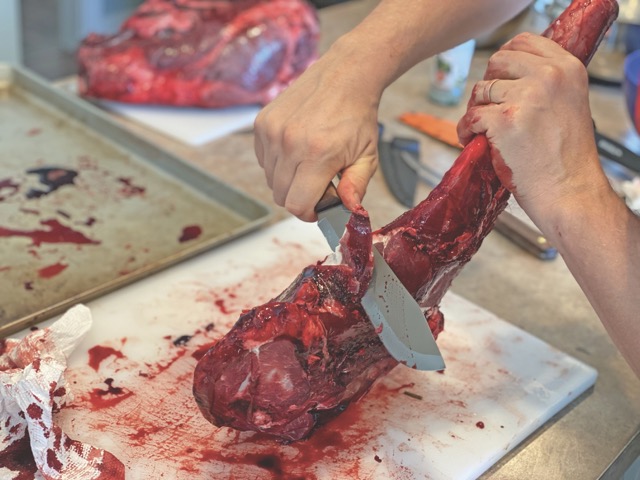
The blade is oddly shaped for use as a boning tool. The bowie-style point is hard to use in tight spaces and doesn’t allow for the “scoop motion” when getting meat out of valleys in the bones. Where it does well is in breaking down large sections of meat on the table. The blade shape puts virtually all the pressure on the belly near the tip; the rear edge nearest the handle is seldom used due to the blade’s inability to get close to the cutting board for slicing strips. Once the belly of the blade gets dulled, its ability to cut and slice dramatically decreases and it needs to be sharpened. I’d rate this as a functional general-use knife for the kitchen, but its utility as a boning knife is questionable.
Scalpel Sharp Boning Knife: Benchmade Meatcrafter
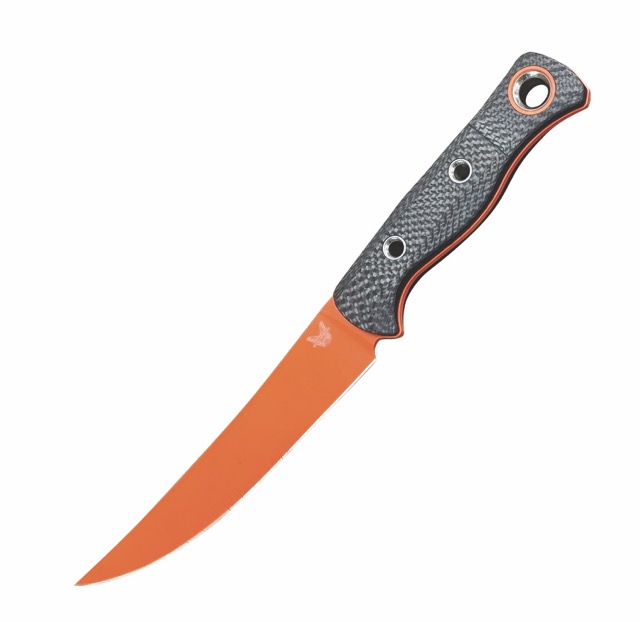
Pros
- Exceptional Sharpness
- Premium Craftsmanship
- High-Visibility Design
Cons
- High Price
BENCHMADE MEATCRAFTER
BLADE LENGTH: 6.08″
STEEL: CPM S45VN stainless
FINISH: Cerakote™ coating
HANDLE MATERIAL: Carbon fiber
SPECIAL FEATURES: Ergonomic and extremely sharp
WEIGHT: 4.52 ozs.
OVERALL LENGTH: 11.06″
SHEATH: Black and orange polymer
COUNTRY OF ORIGIN: USA
MSRP: $400
The Benchmade Meatcrafter* in this story is the first production version of this particular model from the company, literally the first of its kind off the line. It is a high-end knife eight times the price of each of the Knives of Alaska models tested. Benchmade’s quality is evident and this status symbol is not a “safe queen.” It is one of the sharpest—if not the sharpest—knives I have ever seen from the factory. I was actually taken aback when it went through a huge deer ham with no effort. It is scalpel sharp and held that level of sharpness the entire test. I for one was not used to a knife this sharp. I had to retrain my hand to use less force in cuts because it was risky.


This is a knife I would proudly use and display, but even with its orange blade (for higher visibility). I would be very cautious in its use for fear of breaking it. This is one that I know I’d fear losing at the cost alone. Things happen in the field, and I’ve lost a lot of gear. The reality is I’d rather break or lose a $50 knife than something like this.
Meatcrafter Deals
Read More On Game And Butcher Knives:
- Unzip ‘Em: Best Gut Hook Hunting Knives
- Brisket Knife: These Carving Blades Are Bad To The Bone
- Best Hunting Knife: Four Fab Factory Fixed Blades/li>
- Best Ulu Knife: Background And Buyer’s Guide
Scottish Swords: Cold Steel And CAS Iberia’s Tartan Edge
Swords with a Scottish pedigree get two impressive reproductions.
People tend to look at the past quite romantically, and, in no uncertain terms, seem to have a love for those who died while living passionately, even if it meant the end of their way of life. This type of Shakespearean melodrama played out across the world over the centuries, especially when one industrialized nation defeated and subjugated people with a decentralized clan system. The scenario transpired time and again in Europe, America, the Orient and more. The idea of what might have been in a traditional, seemingly carefree society is something many cling to today as progress inevitably marches on toward an unknown, uncharted destination.
For the traditional Scottish clans, the quest for self-determination ended on April 16, 1746, in the Battle of Culloden. A significant reason for their defeat came not just from their tactics but also the weapons that were used. Meanwhile, along with their defeat went their widespread ownership of swords and guns.
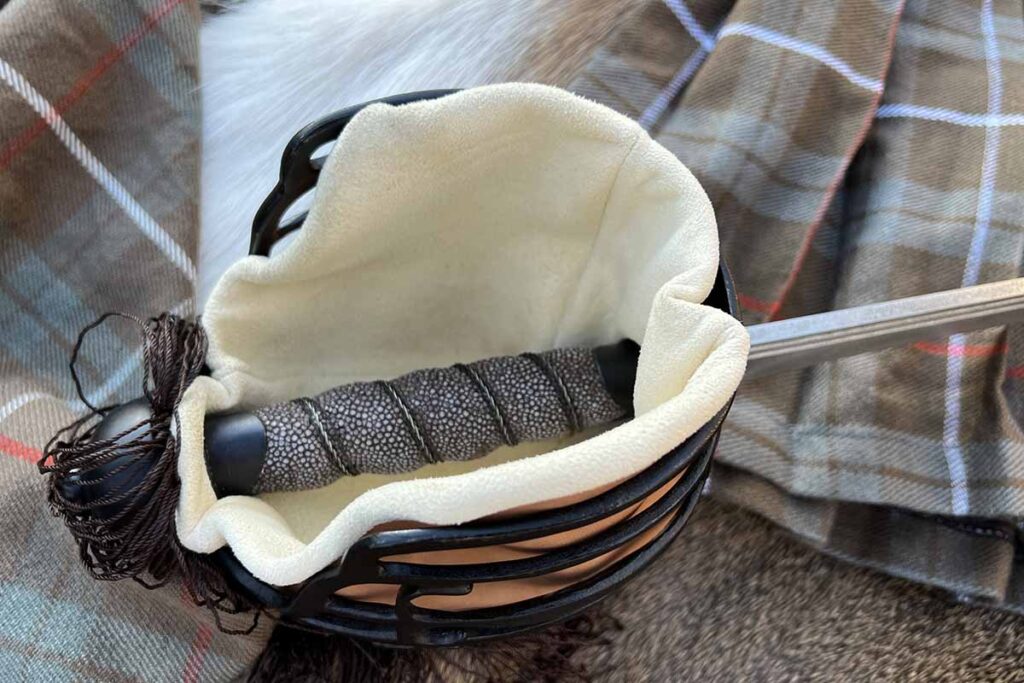
The Scots, especially the Highlanders, were tartan-clad savages capable of easily overwhelming and annihilating the British by use of ambush at extremely close range. In particular, the Highlanders were adept at destroying British formations using a tactic called the Highland Charge. The tactic involved what is essentially a human wave attack with sword and shield wherein the Highlanders charged at full sprint directly into the enemy, often before the latter could fire a shot. When attacked with such speed, the British soldiers were at best able to get one, maybe two shots out of their muskets before they were completely overcome and cut down. Knowing this, the British commander, the Duke of Cumberland, trained his soldiers to repel this devastating attack.
Traditionally, the Scottish warrior carried a sword and a targe. A small shield held in the weak hand, the targe was used to deflect bayonets and swords while the Highlander brought his blade down on his enemy’s exposed neck and head. This was an incredibly effective tactic; it rendered the musket nearly useless and prevented the British soldier from being able to fight by simple bayonet thrust. The British commander instructed his men to not fight the Highlander directly in front of them, as they would surely be cut down in a heartbeat. Instead, he had each British soldier focus on one Highlander over; when the Highlander raised his targe to deflect a bayonet, the soldier would stab the Highlander’s exposed under arm. The simple change in tactics resulted in a devastating loss for the Highlanders, who, for decades, had fought proudly with their bold method. The resulting battle would see thousands of clansmen dead and a complete British victory.
Scottish EDC

The Scots revered the steel and often swore their oath on it. Like many traditional cultures, the Scottish clans held their swords as sacred and a substantial majority of men carried them every day. Unlike the Japanese and their feudal system, where only samurai could carry swords, the average Scot could carry one if he could afford it. It was not a small purchase, and to have a sword was a display of wealth. The swords were often passed down, though it should be noted that at the time of the Battle of Culloden, there was a significant number of in-fashion designs that existed among the Highlanders, meaning that new blades were being purchased regularly.
Among these was the backsword, a fashionable sword that featured a triangular cross-section with a single-edge blade. This type of blade was common throughout Europe and saw favor among the Highlanders, as it was a weight reduction over the double-edge broadsword. The double-edge broadsword could accomplish virtually all its tasks with its tip and lower edge; its upper edge was something of an accessory in that it was not typically used for reverse cuts. The broadsword’s hilt was completely engulfed by a protective basket. Upward swings with this type of sword are awkward and do not lend themselves to significant leverage. The backsword remedied this by shaving over a pound off the sword’s weight while reducing none of its function on the battlefield.
Culloden Types

The two featured reproductions of Scottish swords, one from Cold Steel and the other from CAS Iberia, are exceptionally well-constructed, functional swords made of modern materials and blade steels. There are, of course, custom swords out there, but expect to pay well into the thousands to get one from a top maker. They are not easy swords to make, and the fact the two companies sell them for the stated price points is a great deal—if nothing else, a steal.
The two are variations of swords that would have been present at Culloden. Cold Steel’s is reminiscent of the traditional double-edge Scottish broadsword. The CAS Iberia repro is of a single-edge backsword, something quite common for the time, and arguably the last evolution of the combat sword before guns took over. These are functional repros; they arrive sharp and the blades are very capable of delivering cuts and slashes. As with any real sword, they aren’t meant for chopping lumber or taking down brush. They are fine conversation pieces and, at worst, attractive wall hangers.
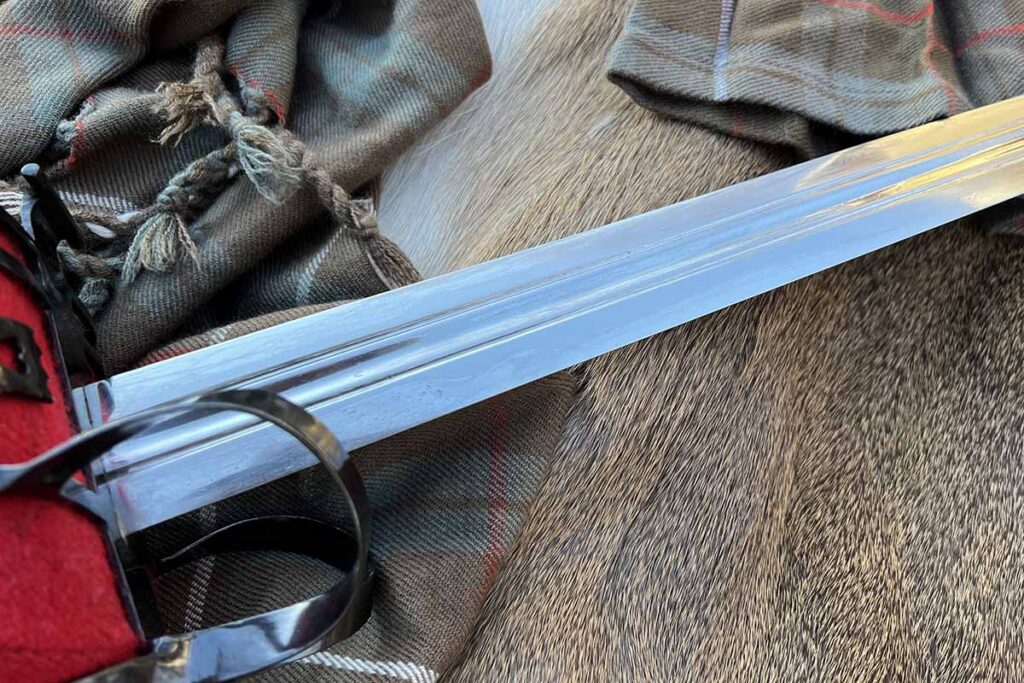
Being versed in some swordplay, I put the swords through their paces. For cutting ability, the Cold Steel version is an absolute beast. The blade is tough and can chop and stab through cloth, leather and even light metal. A wide range of objects were cut, from heavy cardboard tubes to deer carcasses. The Cold Steel showed no edge deformation and the finish was hardly scuffed. The only downside is that the hilt and basket area are very large, and I have large hands at that. Ideally, a baskethilt will contain the hand while not allowing a great degree of front-to-back play; this heavy-bladed piece wants to pull out of the hand on hard strokes. I’d like to see the basket be slightly lighter in construction and the grip a half to 3/4 of an inch shorter.
The CAS Iberia backsword has an antiqued etched finish and, at least for my purposes, just about the most perfect grip size possible. The Cold Steel sword is impressive and powerful but lacks some refinement. The CAS Iberia sword is elegant, light and supremely easy to wield. It’s not as sharp or heavy as the Cold Steel but capable of lightning-fast slashes and deep stabs. The top of the tip has a false edge that could easily be sharpened, and the narrow, diamond-shaped cross-section allows for effortless punctures through most materials. It is hard to even feel it go through most materials, from fabric to flesh. The downside is the blade finish. While it is interesting and adds character, it is also a trap for moisture and needs to be kept well-oiled.
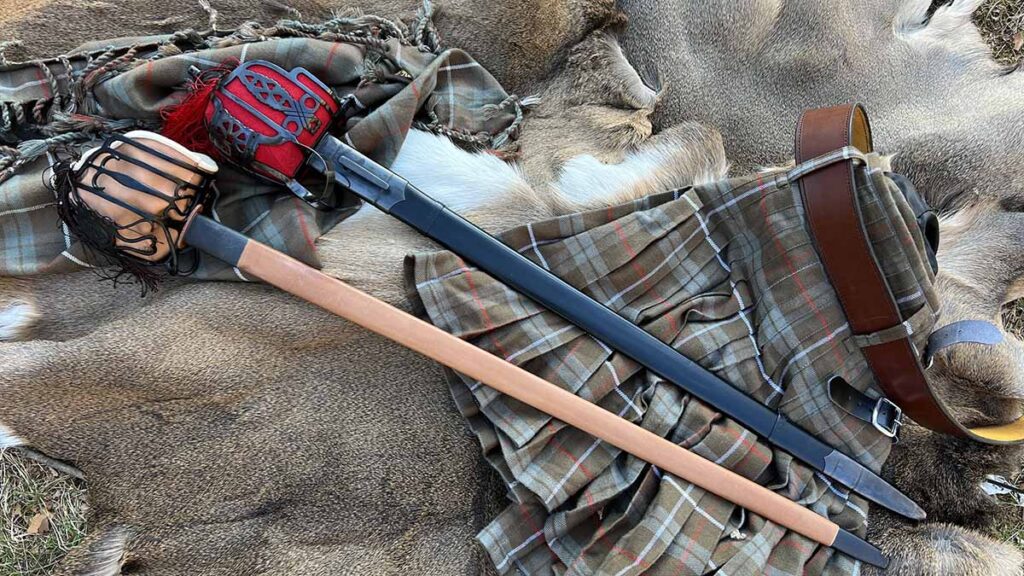
Both swords come with very nice leather scabbards. They match the swords’ fixtures and should be compatible with a wide range of hangers or sword belts. The scabbards are also very close to how the originals were made, though like most things today there are some liberties taken with internal construction.
Duly Impressed
Overall, I’m extremely impressed with the featured swords. If it were up to me, I’d take the blade from the Cold Steel and fit it to the basket and grip of the CAS Iberia, making a sword fit to my hand that can deal hard, deep strokes.
For what it’s worth, you can’t really go wrong with either sword. They are cool and should make conversation starters at your next viewing of Rob Roy, Outlander or any other applicable Scottish-themed flick.
SCOTTISH BASKETHILT SWORD SPECS
STYLE: 18th-century Scottish baskethilt broadsword
COMPANY: Cold Steel
BLADE LENGTH: 30.5”
BLADE MATERIAL: 1055 carbon steel
HANDLE MATERIAL: Blued-steel baskethilt; handle is wood wrapped in rayskin and wire.
WEIGHT: 53 ozs.
OVERALL LENGTH: 37.75”
SCABBARD: Black leather w/blued fittings
COUNTRY OF ORIGIN: India
MSRP: $299.99
AUTHOR’S NOTES: An authentic, functional replica; a bit heavy overall, but solid and well-constructed
SCOTTISH BASKETHILT BACKSWORD SPECS
STYLE: 18th-century Scottish baskethilt backsword
COMPANY: CAS Iberia
BLADE LENGTH: 33”
BLADE MATERIAL: 65Mn carbon spring steel
BLADE FINISH: Antique
HANDLE MATERIAL: Blackened steel baskethilt with “beastie” plaques; handle wrapped in rayskin and wire
WEIGHT: 50 ozs.
OVERALL LENGTH: 39.5”
SCABBARD: Tan leather w/blackened steel fittings
COUNTRY OF ORIGIN: China
MSRP: $565
AUTHOR’S NOTES: Period correct to the Battle of Culloden and based on a sword in the United Kingdom’s Royal Armouries. While more costly than the featured Cold Steel repro, it has the feel of a more balanced and elegant sword.
Read More On Swords:
- Japanease War Swords
- What Are Menuki?
- How To Make A Hamon
- Japanese Swords Remain Iconic
Best Buck Knife: What Are The Company’s All-Time Classics
Buck Knives is among the most historic manufacturers in the county. We attempt to pick the best knives it has ever created.
The famous 110 Folding Hunter was introduced to the market in 1964. This was a significant point for Buck Knives, and a significant point for the knife industry as a whole.
Buck did not start in spirit in 1964, it began much earlier at the turn of the century, and was the culmination of over half a century of Hoyt Buck’s knifemaking experience. Several generations of the Buck family worked to build the company, and the result was nothing short of extraordinary. Buck Knives are one of the most recognizable brands in the country, and they have a well-earned reputation for quality. It is currently in its fourth generation of family ownership, an amazing feat in today’s fast-paced corporate environment.
Buck knives are exceptionally well-made and will hold up for a lifetime if properly maintained. The knives also carry one of the best warranties in the industry which guarantees their products against any defects for life. This whole segment has nothing from him about how Hoyt formally started and built the company.
History Of Buck Knives
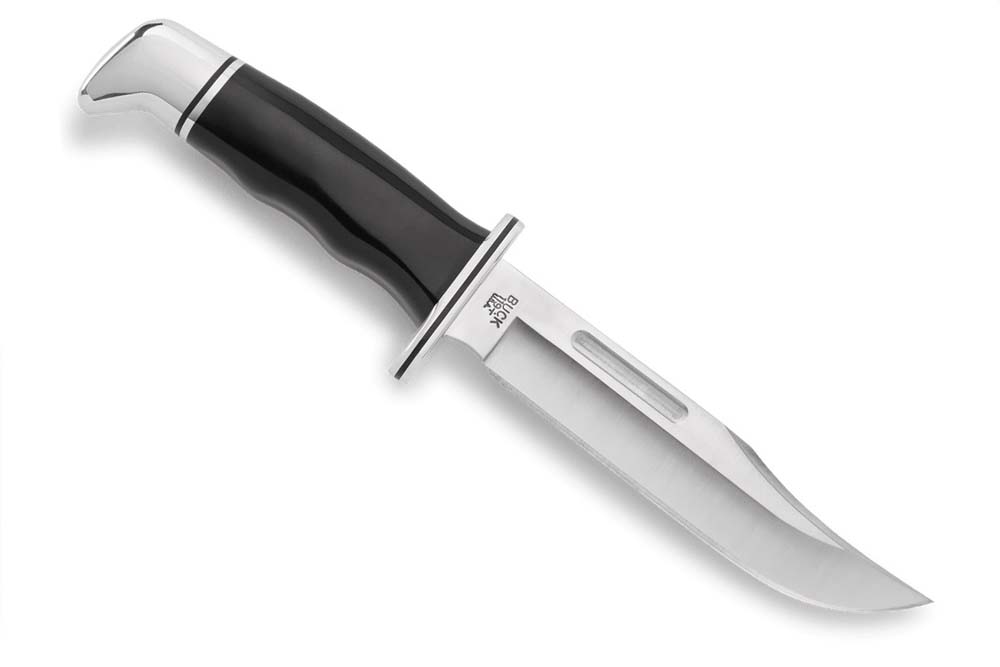
While it was not technically a company, Hoyt buck began making knives around 1900 and developed a way to temper steel that he deemed to be superior to what was being done at the time. It may seem a bit uppity of an apprentice blacksmith to take on something that had not been done in all of the history of man’s knife-making, but Hoyt Buck was not to be deterred.
Sure enough, his methods became well-known and he made knives one at a time for decades afterward. His knives had superior edge retention as a result of his tempering process and to this day Buck knives are well-known for their ability to hold an edge.
While the seeds of Buck Knives were planted thanks to Hoyt and his skill on the anvil, the company’s journey is so much more than that. Hoyt had six children, and his oldest son Al would eventually play a key role in the company’s growth.
By 1941 Hoyt and his wife were now living in Idaho, and he was a church pastor. However, the attack on Pearl Harbor roused his patriotism. As a way to help the war effort, he opened a small blacksmith shop in the basement of his church and began making knives once again. His knives became extremely popular on the military bases on the Pacific Coast and soldiers would come from all over to get one of his blades.
By the time the war ended in 1945 Hoyt and his wife Daisy decided to move south to San Diego and live near Al. In 1946 Hoyt opened his first manufacturing plant, really just a small lean-to attached to Al’s house, with his son. It was then that Buck Knives was officially born.
Al took over the company when his father passed, and today the company remains in the family as CJ Buck is the fourth-generation CEO and Chairman of Buck Knives.
Hoyt’s Tempering Process
Hoyt Buck was 13 years old and an apprentice blacksmith in 1902. According to the company’s own history, Hoyt was dissatisfied with the edge hardness on common farming implements. Farmers seemed to be bringing in their tools far more often than he liked to see and thought of some solutions to make the edges stronger and able to hold their sharpness longer. He began experimenting with these tools and eventually figured out a quenching method to achieve his desired result.
Essentially, the secret Buck discovered was quenching the entire blade when it was all precisely the same temperature. Not an easy task, especially in the day and age he came up with the process. However, overcoming the technological challenges reaped impressive benefits. The uniformity of the tempering process ensured the metal had no soft spots–weakness that could eventually lead to damage. Furthermore, the even tempering–when applied to knives–resulted in blades that were extremely hard and were capable of retaining an edge.
How To Date A Buck Knife

Unlike many knives across the industry, Buck knives are marked in certain ways to identify them based on the year they were made. The original Buck knives from 1961 to 1967 or simply stamped with ‘BUCK’.
From 1967 to 1972, the knives featured the mark ‘BUCK, USA’. The 1972 to 1986 period had the knives labeled with ‘BUCK 110, USA’ with additional model information. From 1986 onwards, each year of manufacture has a unique symbol that is added to the blade. You can very quickly and easily identify this and match it to the model year on the Buck website.
Buck knife collectors tend to have some of their own methods for identifying early knives. While it comes down to a degree of pseudoscience, there is demand for Buck knives that retain their original packaging, and even original receipts that can prove the age of the knife. Typically, the older the knife, the more it is worth.
Vintage Buck knives do not tend to sell for all that much by comparison to other knives, but there is a healthy following all across the country. Most people do not sell their Buck knives at all, and they are passed down generationally.
Best Buck Knives
Whether it’s a contemporary knife or a classic, these 10 knives from Buck continue to be top sellers and beloved by knife aficionados around the world.
110 FOLDING HUNTER KNIFE
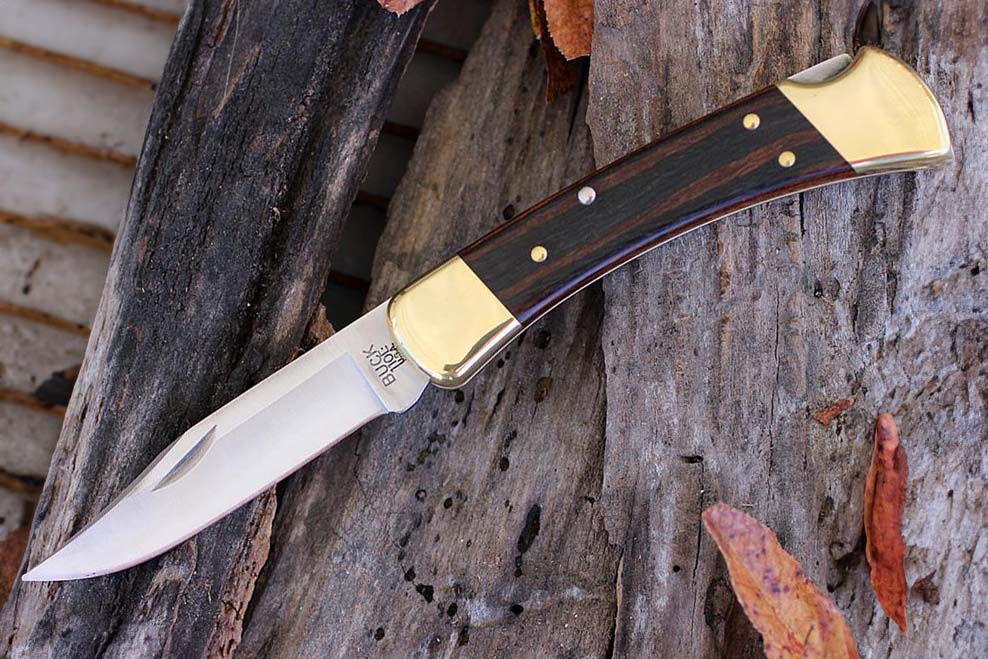
This is the one that started it all. The 110 Folding Hunter needs no introduction here. It is one of the most storied and respected knives in American history. What is remarkable is that the price is relatively low, even for Buck’s lineup. The price of this knife sets it apart because it is well-known for its durability and sharpness. At under $70, you can easily buy this knife without breaking the bank.
MSRP: $65
124 FRONTIERSMAN KNIFE

This knife harkens back to the old days in appearance but is all modern in terms of execution. The Frontiersmen knife is just about the perfect size if you prefer to carry a fixed blade. The design of the knife is completely functional and you should be able to accomplish just about anything you need to accomplish out in the woods or around the farm.
MSRP: $185
055 ‘THE 55’ KNIFE
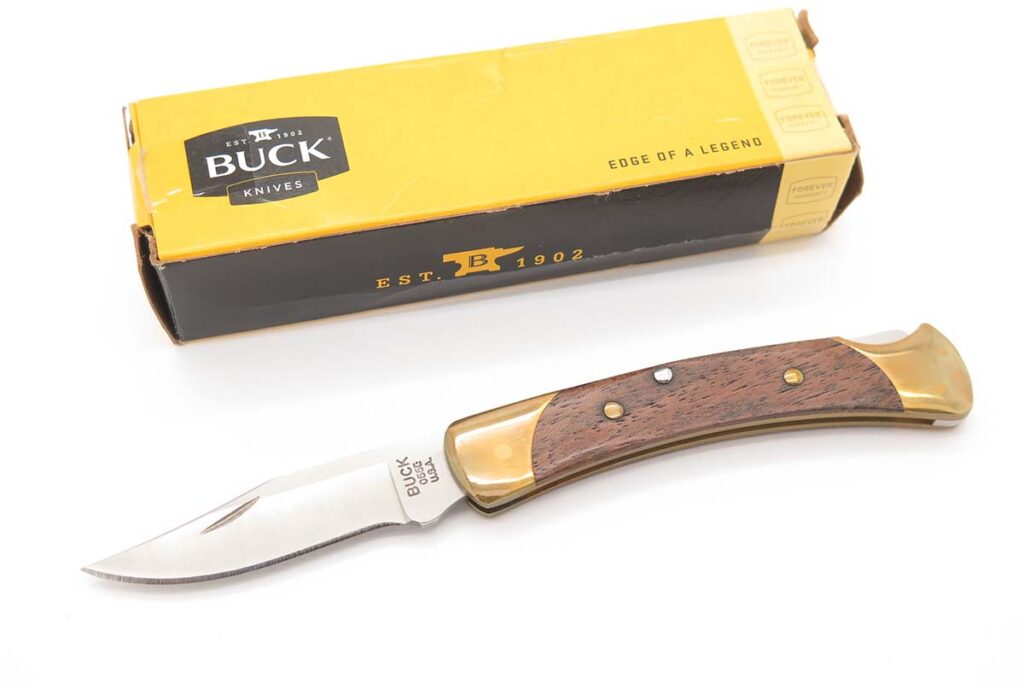
The 55 gets its name for being half the size of the famous 110. It is a popular and common pocket knife that is just as strong as its big brother. While it lacks many of the features of modern assisted-open knives or other types of more complicated designs, it makes up for it by being exceptionally durable and easy to use. Much like the larger 110, this is a knife that you will keep for life and pass down to your kids.
MSRP: $70
120 GENERAL KNIFE
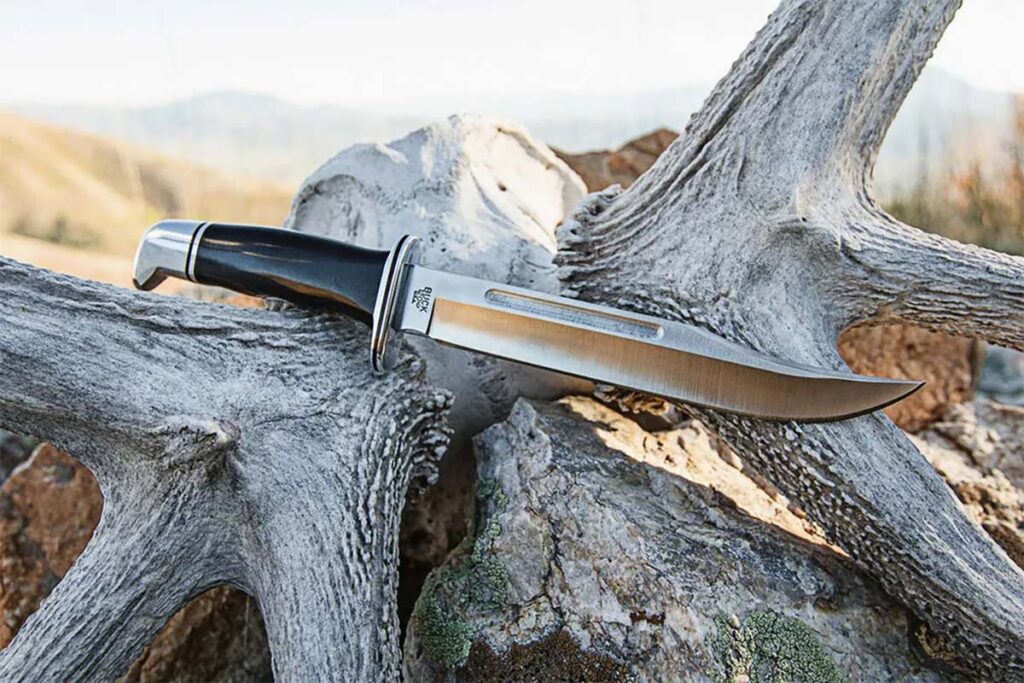
There are very few knives that are as recognizable as the 120 General Knife. This Buck design is a classic, reminiscent of the military Ka-Bar. It is a bigger knife than what most people use for their everyday chores. The General Knife will be a companion for hunting, skinning, and preparing wood near the campfire.
MSRP: $130
103 SKINNER PRO KNIFE
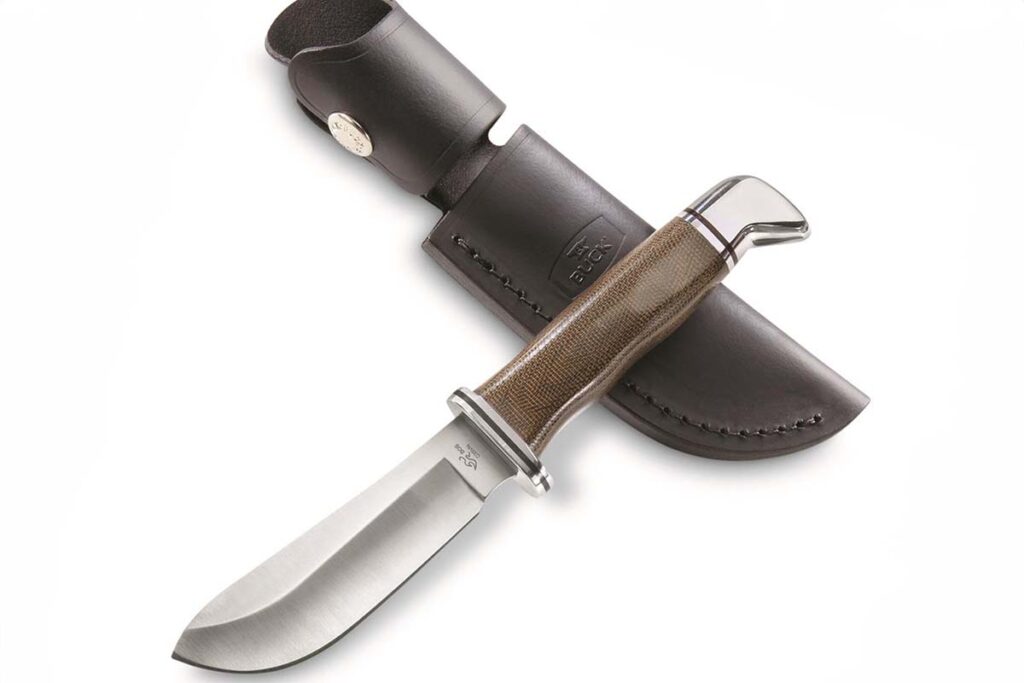
Back in the old days, a skinning knife was part of a larger set that you would take into the field. This knife profile saw its heyday during the decimation of the buffalo herds. Buck has an excellent skinning knife in the form of the 103 Skinner Pro. It is a fine tool and is exceptionally attractive in appearance. If you like to have separate tools for your various hunting chores, you would do yourself well to equip this knife alongside the larger 120 General Knife.
MSRP: $170
102 BUCK WOODSMAN KNIFE

For many young men, the Woodsman was the first serious knife they ever received. This is a classic design and is among the most popular and well-recognized American fixed-blade knives ever made. It is not the largest knife Buck has made, but this medium-sized Bowie profile blade has seen more use than most knife models could ever hope to achieve.
This is an excellent knife for the aspiring outdoorsman. It can be used in just about any setting that requires medium lifting. It is a bit too thin to be used for wood splitting but can be used easily for making kindling by scraping. It is also an excellent small game knife and can be used for all sorts of camp chores. If you think about the knife that you would have in the Scouts, this would likely be as close to that knife as you can get.
MSRP: $75
BUCK ZIPPER KNIFE

The Buck Zipper knife is arguably one of the most popular gut hook knives in the country, and it is fair to say that it is in more deer hunters’ hands than it’s not. As far as traditional designs go, the Zipper knife is not just well-made, it is also a symbol of the trade for many hunters that take to the field every fall. Gut hook knives do have other utility, they can be used in fishing settings for cutting line and for gutting as well. For a general-use hunting knife, you really can’t go wrong here.
MSRP: $129.99
863 SELKIRK KNIFE w. FIRE STARTER

Bushcraft knives are all the rage these days. There are a plethora of TV shows dedicated to the topic, and it seems that every knife company out there is making something that fits the bill. The Selkirk knife is a nicely priced addition to the Buckline. The knife is well equipped and comes with a durable micarta handle and a sheath-mounted fire steel. The kit you get is able to function right out of the box. You can pretty easily get started with practicing right in your yard. MSRP $80
The knife does have a couple of downsides, though, from a Bushcraft perspective, it is relatively thin. A blade really needs to have some meat to it to be able to make it through the tanning for kindling You’ll never really get much life out of a thin blade if you snap it off in use. Even though Buck has a good warranty, you should take care to not treat a thin blade like this as a dedicated tool for splitting. The knife can, however, be used for making tinder out of smaller pieces of wood, and it should have no problem getting them to light.
MSRP: $80
841 SPRINT PRO KNIFE BURLAP MICARTA
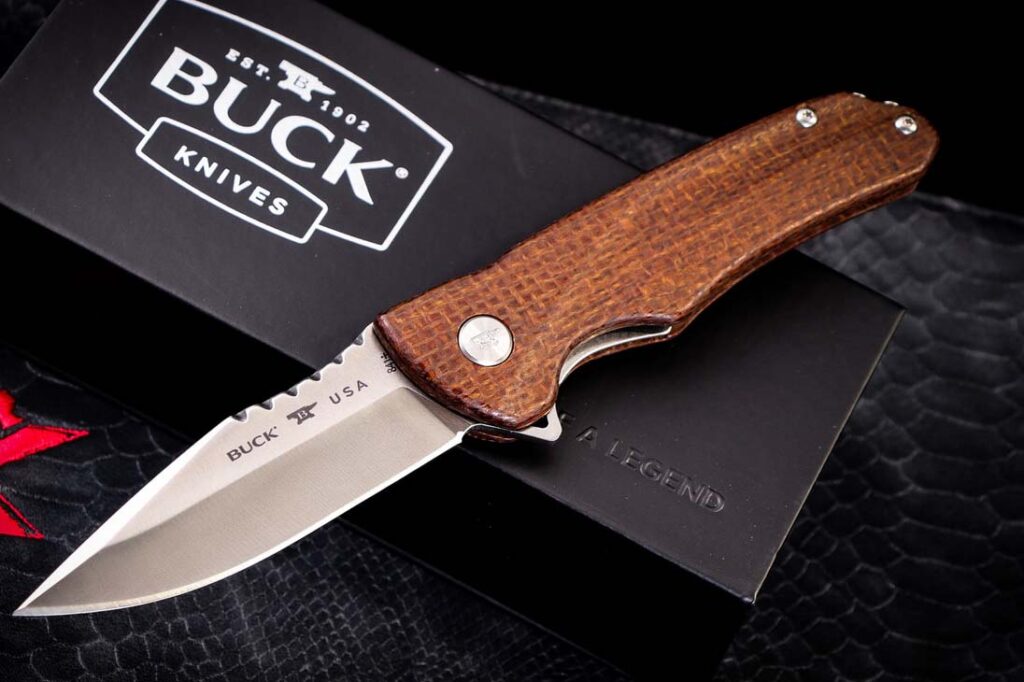
Another modern design, the Sprint Pro is a sleek looking folder that also has some classic lines. The knife is available in a couple of forms, most interesting is the burlap micarta model. Burlap micarta is made through an interesting process that suspends fabric in a resin base material. The result is a unique, very durable, and highly functional grip material that looks as good as it performs. This is a flipper-style knife and can be operated easily with one hand. The locking mechanism is a standard liner lock. Overall, it is a well-reviewed and well-designed knife that, while not the most visually striking, will give years of use.
MSRP: $155
417 BUDGIE KNIFE
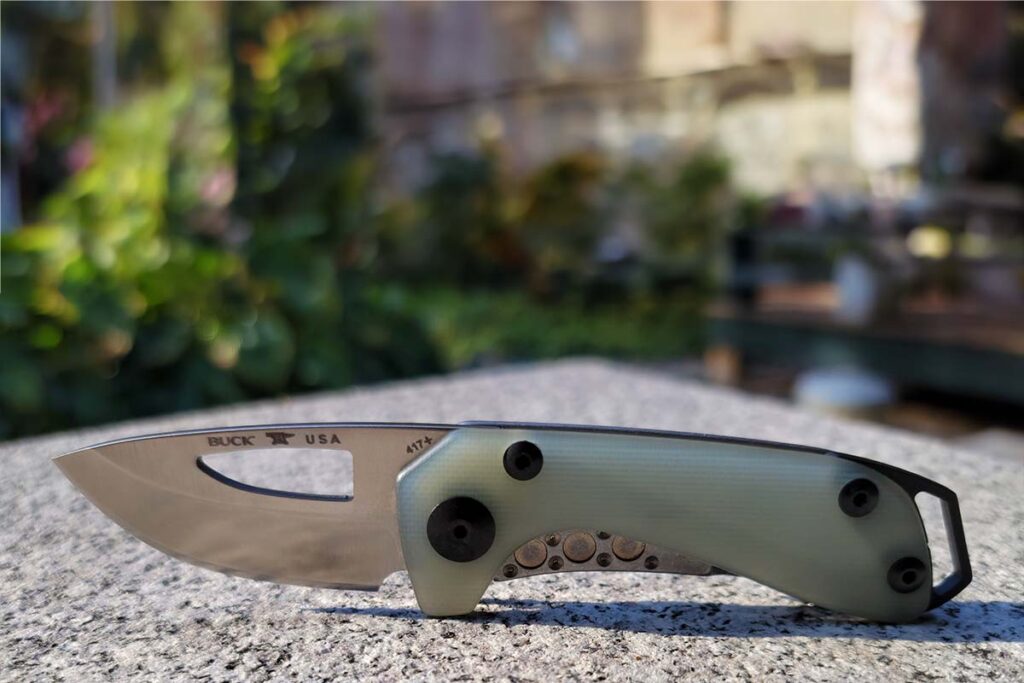
The Budgie is a very compact EDC knife that can go just about anywhere. The tiny design is minimalistic yet functional. It is a frame-like design that is available in a couple of colors, most notably natural green G10. This is a new design that does not necessarily have much in common cosmetically with the classic Buck lineup. That said, it is just about all the knife the average person needs for their daily life, and it can be kept on the person quite easily. While it is a bit more costly than the average mini pocket knife, the Budgie is backed by the same warranty extended to all Buck products and is going to last you for quite some time performing light and medium-duty tasks.
MSRP: $100
Read More
- First Look: Buck 842 Sprint Ops Pro
- First Look: Buck 149 Hookset Breaker
- First Look: Buck 263 HiLine
Throwing Knives: Ready For A Serious Fling?
Ready for a serious fling? We have the throwing knives–some of which are on target–to get you flying right off the bat.
While you’ll never nail an enemy sentry from 87 feet like Skeeter Vaughan reportedly did with a throwing knife during World War II, you can score a number of bull’s-eyes with today’s throwers.
To test some of the latest airborne blades, I visited my buddy’s house. Together with a few friends, we had a good ol’ time flinging the throwers at a wood target.
Unlike many of my other BLADE® articles, I went into this with very little experience or prior knowledge, except that which I learned from previous backyard throwing sessions. None of my friends had additional experience, except for a buddy’s wife who was probably the best among us as far as results went. I feel that this was probably the best-case scenario.
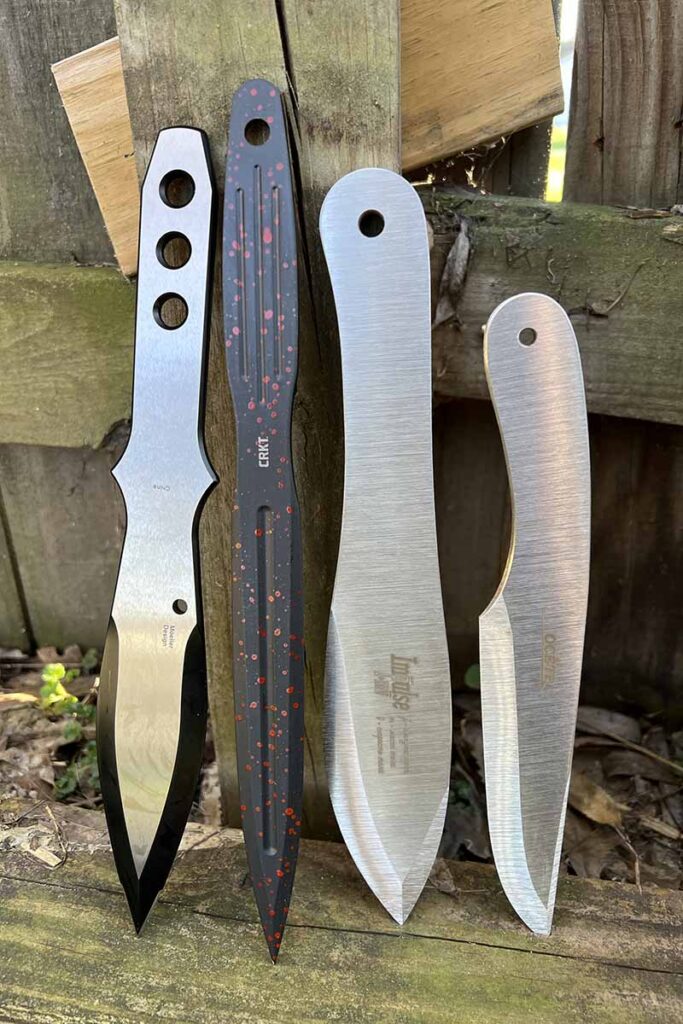
In testing knives other times I went in with tons of previous experience from hunting, bushcrafting, skinning, fishing and other outdoor activities. The playing field was thus level and I was going to get the purest experience from these knives, as I had no prior notions of what success looked like—other than having fun.
As with most knives, there’s a science that goes into making throwers. I am in no way an expert. I approached the story with the distinct impression this would be more difficult than I thought. Most who are into throwing knives buy for either pure recreation or actual skill-building for competition. While I have no statistical way to prove it, I feel that 99.9 percent of people who buy throwers do so for recreation in the backyard, during cookouts with friends and family, etc.
Throwing Knives Tested
The featured knives are all factory made. The Spydercos are shaped like leaf-blade daggers with a slight crossguard and sharp, diamond-shaped tip. They come in a set of three with a handsome but tight-fitting leather sheath that will require a bit of break-in. While the knives all fit, the overall package is a bit heavy. The Spydercos were easily the favorite of the testing. They can be thrown with good accuracy using a variety of techniques. Out of the reviewed group they are a good starting set and offer the most feature-wise for the thrower looking to gain skill.

Designed by BLADE Magazine Cutlery Hall-Of-Fame® member Ken Onion, the CRKT entries likewise come in a set of three, though are far more minimalist in design. They are long and thin, with a red-and-black-splatter-finish scheme. The knives come in a black nylon sheath. The profile of the knives is quite thin with a slender cross section. They are well balanced but have little meat mid-knife, making them have an iffy rotation in flight. The knives did perform well but were more or less hard to index in the hand.
The two Russian-made knives from Kizylar Supreme vary in appearance, one reminiscent of a drop-point field knife and the other a large leaf-blade profile. The knives are roughly finished and have some issues when in use, which I’ll detail more below. The knives are somewhat hard to get these days with the various trade situations with Russia, but I wanted to put them through their paces anyway. They are solidly built and very rugged but are not for everyone. Neither knife came with a sheath or storage case.
Results
Factory-made throwers are, at least in my years of backyard trials, inconsistent at best and largely made to look cool. Most of these knives, including the ones used in this review, were only loosely able to give consistent results. The Spydercos were probably the most consistent among the people I roped into testing them. This was in large part due to the fact that one of my friends employed an underhand throw, using the holes in the handle as pendulum points to help get a consistent rotation.
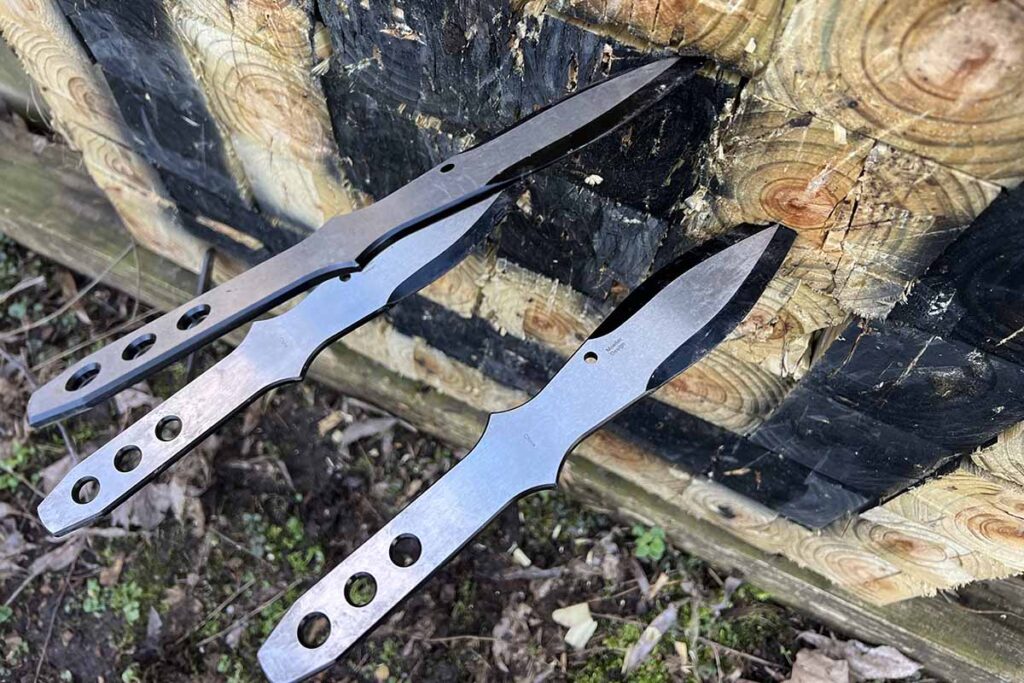
Weight distribution among the review knives was all over the place. The Spydercos were a bit heavy across their entire length, but they did fly true for the most part. The CRKT knives ran into a bit of trouble with their relatively thin profiles. They seemed to easily spin out and rotate along the tip-to-pommel axis if they caught the air wrong. They were also significantly lighter than the rest, which made it just a bit difficult to gauge their feel in the hand when throwing. Most of the reviewers felt the Spydercos were the best, though perhaps a bit too heavy. The CRKT knives certainly look the coolest but were a bit too light and thin overall for true consistency.
The two Russian knives were the poorest performing in the test, mostly because they were just so large and heavy that they seemed to have no point of balance at all. Out of five people, myself included, none made consistent throws with either of the knives. The weight factor was a main issue. The knives are heavy, like throwing a piece of raw bar stock. We tried just about every possible style of throwing: overhand, underhand, tip hold, handle hold, etc. None of us could make them stick with certainty. This toyed with me because, in theory, a heavier knife should be easier to develop muscle memory with and should maintain more energy on impact to drive the tip home.

The tip profiles on both Kizlyar knives were wanting. Where the others were actually sharp and very pointy, these knives had a very thick, squared tip that resulted in a good number of bounce-off hits even if we got them to land straight-on. My only thought about this is that some provinces have restrictions on shipping sharp edged swords or specialty cutlery, with some places in Europe requiring a 1-millimeter edge so it’s not too dangerous to exist in their nanny states. If the intent is to sharpen the knives at home, it makes these the only throwing knives I’ve ever encountered that are not ready to go out of the box. My only other idea as to why these knives are shaped this way is they may have been intended to strike softer targets, such as hard foam. When used against wood, which I feel is safe to say is the most prevalent knife target material, they seem tremendously unsuited.
Why Fling Flyers?
Throwing knives is a lot of fun, and you should exercise a reasonable amount of caution when using them. If you want to get into the sport, these knives are a good place to start, and you’ll have a great time learning. You really can’t go wrong with any of these. I would hesitate a bit on the Russian knives, but if you have the time and patience, I’m sure that you would enjoy them as much as I enjoyed the struggle and laughs in trying to use them.
SPYDERCO THROWERS SPECS
DESIGNER: Harald Moeller
MODEL TYPE: Large
KNIVES IN SET: Three
BLADE LENGTHS: 6.63”
BLADE STEEL: 8Cr13MoV stainless
HEAT TREATMENT: Tough spring hardness
BLADE TIP: Sharpened diamond profile
BLADE EDGE: Non-sharp
HANDLE MATERIAL: Steel
WEIGHT: 10.2 ozs. each
OVERALL LENGTHS: 11.13”
SHEATH: Leather three-knife piggyback model w/belt loop
KNIFE TO KNOW: The knives are available in small- and medium-sized sets, too. Each set comes with a copy of Harald Moeller’s book, Knife Throwing: The Knives and Throwing Technique of Harald Moeller.
COUNTRY OF ORIGIN: China
MSRP: $166
CRKT ONION THROWING KNIVES SPECS
DESIGNER: Ken Onion
KNIVES IN SET: Three
BLADE LENGTHS: 6.25”
BLADE MATERIAL: 1050 carbon steel
BLADE EDGE: Non-sharp
BLADE FINISH: Corrosion-resistant powder coating
HANDLE MATERIAL: None
WEIGHT: 5.1 ozs. each
OVERALL LENGTHS: 11.66”
SHEATH: Black nylon w/belt-loop carry
COUNTRY OF ORIGIN: USA
MSRP: $75
KIZLYAR SUPREME THROWERS SPECS
DESIGNER: V.S. Kovrov, Russian throwing knife instructor
BLADE LENGTHS: 5.25” (Ocetp), 6.5” (Impulse)
BLADE STEEL: 420HC stainless
ROCKWELL HARDNESS: 42 HRC (edge) and 45 HRC (spine)
BLADE EDGE: Non-sharp
HANDLE MATERIAL: Steel
WEIGHT: 8.4 ozs. (Ocetp), 12.5 ozs. (Impulse)
OVERALL LENGTHS: 9.4” (Ocetp), 10.5” (Impulse)
SHEATH: None
COUNTRY OF ORIGIN: Russian Federation
MSRPs: $49 each
Check Out More Outdoor Knives And Tools:
- Best Bushcraft Knife: When Steel Meets Woods
- Best Camp Knives: Outdoor Do-Alls
- Best Hatchets And Axes For Survival And Camping
- Best Gut Hook Hunting Knives
Fire Starter Knife: Blades Designed To Spark A Flame
Fire-starter knives make sparks when you need them most.
Bushcraft skills have grown immensely in popularity in the past few years. It could be the slew of TV shows promoting survival situations or just perhaps an interest in self-sufficiency. What is true is that the knife industry is playing catch-up to the bushcrafting market, and many new products pop up that have features dedicated to keeping you alive and warm in the woods.
Fire Starting Knives
Recent years have seen an influx of knife features deemed ideal for use with another essential tool—the ferro rod striker. Ferro rods are made of ferrocerium, an alloy consisting of several base metals and magnesium. Magnesium is highly reactive and generates showers of sparks as it is scraped against steel. Think of it as a more modern version of flint. Ideally, the ferro rod is struck against a sharp, acute surface. Many people use the blade’s edge for this, though this is not recommended as dull spots can emerge quickly.
As time passed, people began sharpening the blade spines to 90 degrees, making a hard, sharp angle that is not on the cutting edge. Still, others find this feature annoying, as it is fully possible to injure your hand on a squared spine. I know because I’ve done it.
As a remedy, people started cutting in little semi-circular cutouts into the spine that still retain a square shoulder, thus allowing for safer handling when striking. Both a fully sharpened spine and the sharpened cutout are valid features; it depends on what style you prefer.

The smaller cutout is really just a striking feature but the fully sharpened spine can be used for a number of other ends, most notably an easy and effective means of peeling carrots, potatoes and other root vegetables for the camp kitchen. Many top fire-making knives have sharp-angled spines and cutouts ideal for striking.
Bowdrill Divits
Some bushcraft knives have bow drill divots in the grips. No less than 10 knives I’ve tested in the past year have the feature and I’ve yet to master its use.
A bow drill is a very primitive means of starting a fire with friction. It takes about forever and even then is not a guaranteed success. In terms of time management and the amount of calories used in a survival situation, I really don’t think it is worthwhile, though it’s nice that the feature is there.
The bow drill is basically a stick you press down on while at the same time you spin it with a bow (a stick with string wrapped around it) to create an ember. The idea behind a knife with a divot on the handle is it allows you to make kindling and all the tools you need to make a basic fire. You can use the knife to make the string (plant fiber), the drilling board (piece of dry wood) and bow/drill (stick).

BLADE® Editor Steve Shackleford asked me to test the knives in this capacity as long as it didn’t detract from the other standard knife testing. “Skip it if it’s too much,” he stated. “I don’t want to wear you out.” However, in the spirit of making the story as detailed as possible inside the 1,500-word limit, I tried the TOPS and White River knives with the handle divots to see if I could, in fact, start a fire using the bow drill.
I was unsuccessful with both but did end up getting a fire going with a cheap bow drill kit from Amazon. No matter how you slice it, using a bow drill is just a huge pain in the keister and I’d rather stick a standard lighter in every pocket of my gear and an extra one in my boot than have to resign myself to using a bow drill.
A large reason why I really didn’t like using the divot features was that they really require you to keep the knife in the sheath. Otherwise, you’re just sitting there putting pressure on a knife with the edge floating out in space. It is easy to get into a trance while using a bow drill, and I found myself not paying attention at several points—not a safe situation.
Holding the knives in their sheaths is not very comfortable as they are hard Kydex. There was no real comfortable way to put pressure on the drill while gripping the sheath. Eventually, I gave up and decided if I ever did have to use a bow drill, I’d just find another piece of wood and carve a divot with the knife instead.
White River Knife & Tool FC-PKO
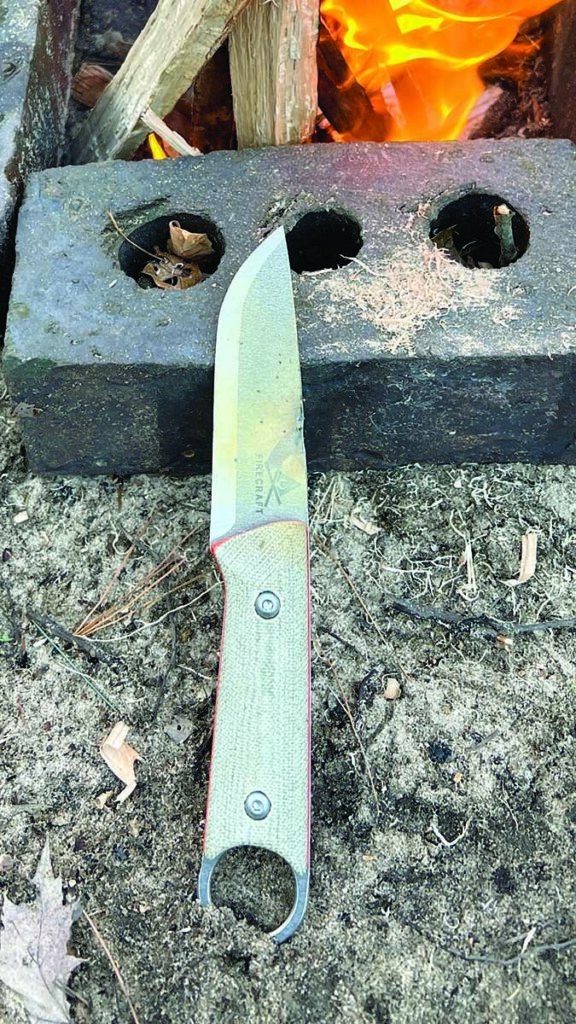
White River Knife & Tool makes excellent knives. In fact, they are some of the most well-laid out and functional I’ve tested in my time with BLADE®. I have used the company’s larger FC7 as my main deer hunting knife in camp and have, between myself and my friends, packed out no less than 50 deer with it. I was happy to review the smaller FC-PKO, sort of a little brother to the FC7.
The FC-PKO is a modified puukko style with a Scandi grind and a ring pommel. The Kydex sheath is low profile. My initial impressions were that the knife is small, thin and razor sharp. I immediately thought it would be a perfect knife for pheasant or duck. I found it a champion at cutting tinder and kindling, but not up to larger work. The knife is an end-stage tool in that it can readily start fires, but lacks the strength and blade thickness to take down anything more than sticks. You’ll need a larger tool to actually prepare the wood prior to using the FC-PKO.
As far as fire-making ability, it is a solid performer. The knife has a small notch on the spine that ignites the ferro rod easily. The edge can trim extremely fine curls of tinder. Where I ran into problems was the ring pommel. I have large hands and long fingers, so this may not be an issue to everyone, but I found my pinky largely just floating in space. I couldn’t get comfortable with the ring. That said, it is overall a great knife that will ultimately see years of service on my belt.
White River Knife & Tool FC-PKO Specs
Knife Type: Modified puukko
Blade Length: 3.7”
Blade Steel: CPM S35VN stainless
Blade Grind: Scandi
Blade at Thickest: .125”
Handle Material: Micarta® w/orange liners and bow-drill divot
Weight: 4.6 ozs.
Overall Length: 8.1”
Sheath: Black Kydex w/striker loop
Striker: Included, basic rubber grip
Country of Origin: U.S.A.
MSRP: $200
TOPS Knives Fieldcraft

The TOPS Knives Fieldcraft by Brothers of Bushcraft is a beast of a knife that weighs nearly a pound and is built like a tank. The edge is razor sharp despite the steep grind and can split medium-size firewood easily. The handle is thick and robust and you can really get a grip on it. I find large knives like this almost too much for regular use, but this one fits into the niche of being large enough for constant use and not too big to be a burden.
The knife has a striker cut in the pommel as opposed to the blade spine. That said, you can order it with a sharpened spine if you wish. I wanted to test the base model to get an idea of what the average owner would experience. If I want to add a sharp spine, I can do so on my grinder or have TOPS do it. The pommel striker is not easy to get used to—you have to find a safe direction to point the blade, which can be difficult. That said, you can leave it in the sheath for this part—just be careful not to launch it out while striking. The cutout is effective once you get used to it.
TOPS Knives Fieldcraft Specs
Knife Type: Full-size bushcrafter
Blade Length: 4.75”
Blade Steel: 154CM stainless
Blade Grind: Modified Scandi
Blade at Thickest: .19”
Handle Material: Tan canvas Micarta® w/red liners and bow-drill divot
Weight: 14 ozs.
Overall Length: 10”
Sheath: Black Kydex w/striker loop
Striker: Included, basic aluminum grip
Knife to Know: There are numerous other Fieldcraft models available in different materials and colors
Country of Origin: U.S.A.
MSRP: $295
Casström No. 10 Swedish Forest Knife
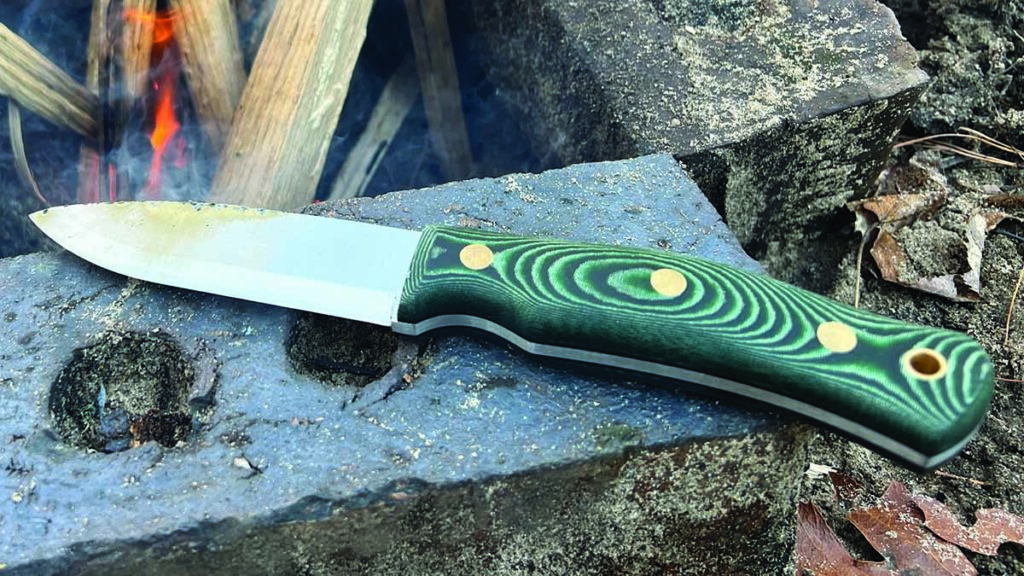
The classic-looking Casström No. 10 Swedish Forest Knife is reminiscent of such Scandinavian knives as the puukko. It is not a traditional puukko but rather a somewhat modern take on the longstanding Nordic tradition of general-use fixed blades. Many American knives in the bushcraft world have a somewhat gritty, tactical feel and a somewhat industrial appearance. The No. 10 is not terribly exciting in looks but hides its function under a gentle exterior. It was my favorite knife in the review, which may surprise you. It has everything I like and nothing I didn’t—not too big, not too small and pleasant to look at.
The knife has a smooth grip—be careful if you’re not wearing gloves, it can get a tad slippery—and a plain, graceful blade. The angle of the spine is sharpened but not so aggressively that it would risk injury. It is not a particularly thick blade but can handle some medium-to-small splitting work if you’re careful, and makes kindling and scrapes tinder well. The knife strikes easily anywhere on the spine and offers a great deal of control. Of note, the sheath is leather and has a ferro rod with a matching green/black Micarta® grip. As a set the knife and rod look very nice together. The rod was also the easiest to hold onto thanks to it having the largest grip area.
Casström No. 10 Swedish Forest Knife Specs
Knife Type: General-purpose Scandi
Blade Length: 3.75”
Blade Steel: Sandvik 14C28N stainless
Blade Grind: Full flat
Blade at Thickest: .13”
Handle Material: Green/black Micarta® w/black liners
Weight: 5.75 ozs.
Overall Length: 8.6”
Sheath: Black leather w/striker loop
Striker: Included, matching green/black Micarta handle
Knife to Know: According to the author, the knife has the most user-friendly sheath of the test bunch
Country of Origin: Sweden
MSRP: Approximately $200
Fire Starter Knife Final Cut
Starting a fire can be a challenge, especially in adverse conditions. Considering just how cheap common lighters and survival matches are, knives like the ones in this article should probably not be your primary means of starting a fire in an emergency. These knives are capable tools that provide a level of redundancy to your kit in some very good, non-obtrusive ways. The base-level skills needed to start a fire can be obtained with each of these knives with relative ease, but you will still need to make sure to have the skills necessary to maintain a fire in the wilderness.
Always be sure that you are not making a bad situation worse with fire, and make sure you’re not using a knife under less-than-ideal conditions. If you have a lighter or matches, use them first, especially in the dark.
More Wilderness Knives:
- Best Bushcraft Knife: When Steel Meets The Woods
- BEST SURVIVAL KNIFE: These 10 Blades Could Save Your Skin
- Last-Ditch Survival Kits
- Is The Scandi Grind The Best For Bushcraft Knives?
Best Rescue Tools & Knives: Must-Have Lifesavers (2023)
Emergencies happen anytime, anywhere. This means, having the best rescue tools & knives at hand is imperative.
When it comes to edged, prying, breaching and other tools for emergencies, there is no one-size-fits-all remedy as no two situations are ever alike. Because of this, many such tools are made to perform a broad range of tasks.
I have taken a fair number of classes and am certified in a wide variety of emergency skills. What I have learned across the board is there is no one right answer, and the tools you have on hand you had better know how to use. (Having these tools on hand or in your vehicle is really what we are looking at here; they must be readily accessible to be of use.)
Let’s take a look at some of the best options when it comes to rescue tools and knives. These instruments can handle situations from cutting a downing person out of a tangled line to prying an accident victim out of a car. And, most importantly, are sized to be at hand at all times.
What Makes A Good Rescue Tool
Given there is no way to prepare for every eventuality, it’s impossible to have one tool to address all emergencies. That said, the supreme value of a rescue tool is its versatility. In general, it should be capable of handling some of the most common tasks faced in most rescue situations, such as:
- Cutting
- Prying
- Breaking Glass
- Mechanical Manipulation
Yes, other situations require other tools. And certainly, there are options out there that are larded with all sorts of doodads to address these. However, these systems can prove overly complex and not as robust as more Spartan designs. Simple, reliable and flexible are the keys.
Buy Quality
It’s easy to blow off preparing for the worst. After all, the worst doesn’t happen all that often. However, when it does do you want to trust your life to a dime-store rescue tool?
Planning means spending money on the best possible equipment. In short, the best rescue tools are made of quality steel, built with robust materials, smartly designed and sized to be part of your kit. When your loved one is strapped into a wrecked car you need to get them out or other such disaster, you’ll be glad you spent the money.
White River Knife & Tool Lifespike
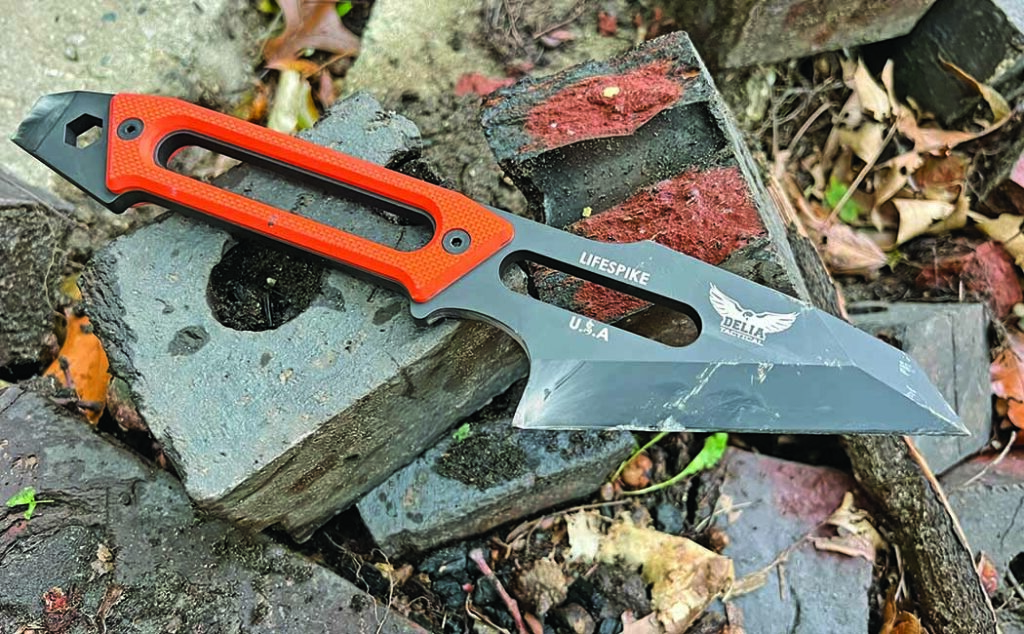
The Lifespike by White River Knife & Tool is arguably the most versatile of the review tools. Designed for first responders, it is an exceedingly tough implement that is very well thought out. However, it is not a do-all-be-all in that it lacks in a couple of important areas. I will cover those areas first to not detract from the utter beast of a tool it is.
The Lifespike really needs a seatbelt cutter integrated into the pommel/pry tip area—just a small one but one that doesn’t necessarily present the sharp tip to the chest. Moreover, the pry end is opposite the sharp tip, and if you try to pry with it you’re going to put leverage on the blade and edge. Hence, a vigorous rescue could lead to the rescuer becoming a rescuee. The location of the wrench socket is also not ideal; the height of the handle scales can impede its utility if trying to turn a bolt.
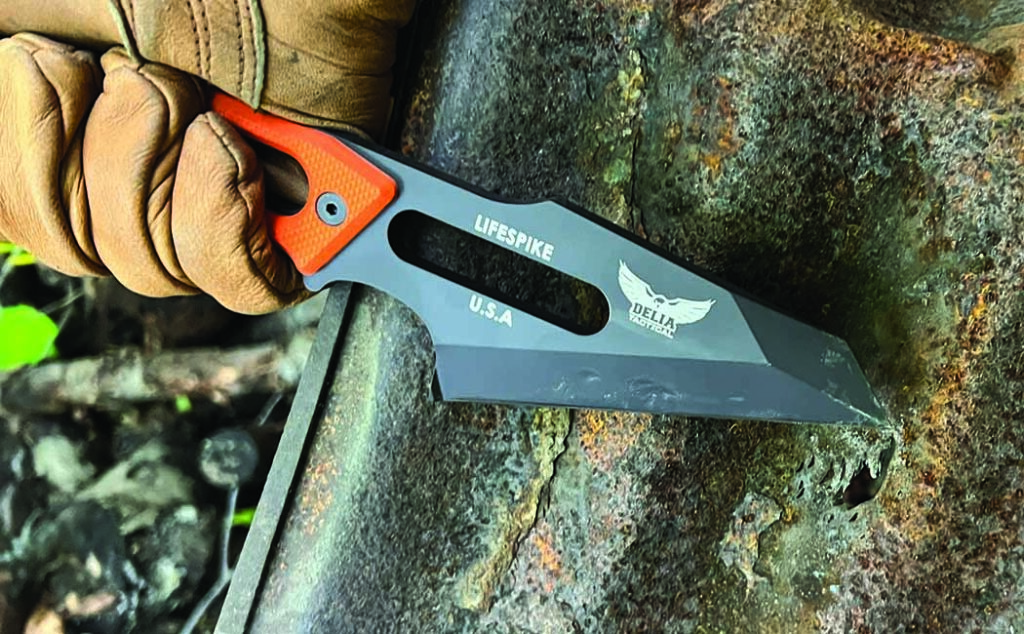
That said, the Lifespike can punch through just about anything. Not only can it penetrate sheet metal with eye-opening ease, if swung like a hatchet it can slash the metal into shreds. It simply blasted through most of the test media and the edge held up extremely well. As far as durability and ease of deployment, you really can’t ask for much more. Breaking glass is possible, but the Lifespike is hard to control in that it doesn’t have a dedicated conical point to use in the role. Overall, I think it’s nearly perfect for dealing with automobile accidents. I’d be confident in using it to force open a door, but by the nature of its design there is the possibility of harming yourself if you aren’t 100 percent aware of where the blade is pointing.
White River Knife & Tool Lifespike Specs
Knife Type: Self-contained rescue multi-tool
Blade Length: 4.65”
Blade Material: 80CrV2 carbon steel
Blade Grined/Edge: Chisel/plain
Handle Material: G-10
Special Features: 1/2” channel gas line wrench, 9/16” wrench, pry bar pommel
Weight: 13.4 ozs.
Overall Length: 11.5”
Sheath: Kydex
Country of Origin: USA
MSRP: $300
Winkler Knives AF-ERT (Air Force Emergency Response Tool)
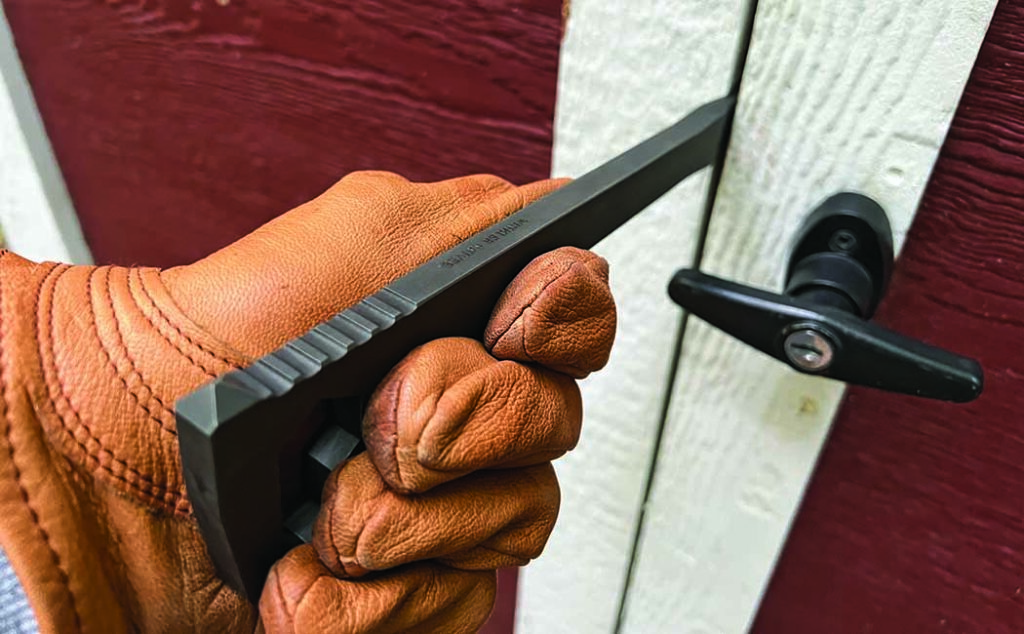
Constructed of the same material as the company‘s knives and axes and bearing the same rugged finish, the Winkler Knives AF-ERT (Air Force Emergency Response Tool) is extremely tough and surprisingly compact. It is so small and slender it can easily ride in the MOLLE loops on your gear. The AF-ERT provides a surprising degree of function and exceptional strength. The head functions not just as a two-size wrench but also as a hammer and a glass breaker. The interior edges of the head cutout are sharp and can even be used to pull a ferro rod through to generate sparks.
The wrench sizes are very functional and work with a wide number of common scope mounts and automotive nuts and bolts. The head, while narrow, is functional as a small hammer. Of all the tools tested, the glass breaker was the most utilitarian and safest to use. It keeps the hand at a healthy distance from the glass and reduces the chance of getting cut. You can also rest the glass breaker on the surface and strike the face of the hammer with another object if you don’t think you can get enough leverage to swing the tool itself. Though it works quite well, the AF-ERT is quite lightweight and doesn’t possess a great deal of momentum when swung.

Prying with the tool is easy; the tip of the prybar is quite narrow and can get into some tight spaces. It is simple to tap it in because the head is flat and not sharp in any way. While not the largest tool, it probably has the most across-the-board daily uses and would not be out of place in a camping bag or glove box.
Winkler Knives AF-ERT Specs
Tool Type: Self-contained rescue multi-tool
Tool Material: 80CrV2 carbon steel
Head Width: 21/8”
Tool Thickness: 3/8”
Tool Finish: No-glare black oxide
Handle Width: ¾”
Special Features: Compact tool that can be tucked into MOLLE loops; features glass breaker, 3/4” and 1/2” wrench sockets, hammer head, nail-split pry bar
Weight: 12 ozs.
Overall Length: 9”
Country of Origin: USA
MSRP: $85
KA-BAR USSF (United States Space Force) Bridge Breacher Tool
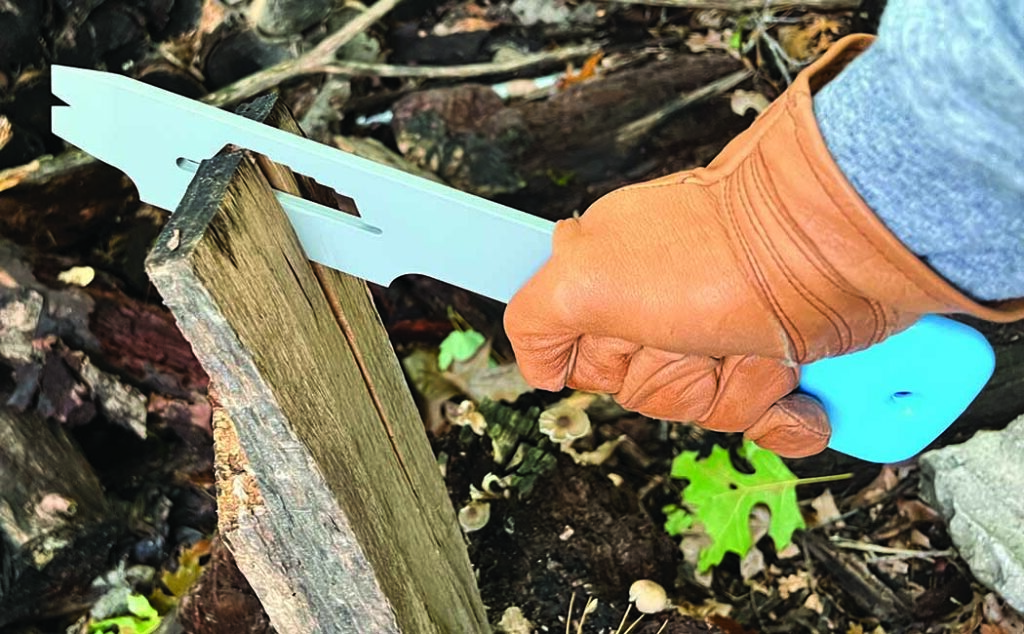
The KA-BAR USSF (United States Space Force) Bridge Breacher Tool is a substantial, heavy piece of steel that can get most emergency jobs done. It has a stepped wrench cutout located toward the tool’s business end. You can operate it from the handle end if you are prying, turning a nut or splitting material. Because of its mass and length, it easily outclasses the other tools when it comes to prying stuff apart.
The Bridge Breacher has a relatively blunt-edged, chisel-like blade on one side for chopping. In a pinch it can even be used to split wood. It bends and crushes metal and does not cut through it the same way as the Lifespike. I am not a huge fan of the squared edges in the grip area. I would like to see them more rounded for comfort, and also something other than the rubberized grip material. If you need to hammer the Breacher in to open something, the grip material shreds away quickly. Nonetheless, it is an excellent choice for the heaviest tasks and for material breakdown.
KA-BAR USSF Bridge Breacher Tool Specs
Tool Type: Self-contained rescue multi-tool
Cutting Edge: 2”
Edge/Tool Material: 1095 Cro-Van carbon steel
Blade Grind: Chisel
Handle Material: Blue Plastisol
Special Featues: Nail-split pry bar tip, slotted wrench cutout, chisel edge
Weight: 1 lb., 9.6 ozs.
Overall Length: 13”
Country of Origin: USA
MSRP: $85
TOPS Knives Pry Knife and Pry Probe Punch (PPP) Tool Combo

The Pry Knife and Pry Probe Punch (PPP) Tool Combo by TOPS Knives is a beefy, substantial dual package. It is truly a hybrid of a prybar and a knife, with some strengths and weaknesses of both. The knife has sharp edges and a very comfortable handle. It handles a wide variety of cutting chores. It can be used to split a dizzying amount of material, and is robust enough to chop wood and even through metal. The secondary edge has a steep angle and segmented serrations for cutting through such tough material as rope. When it comes to prying, the blade can be used with substantial force. Thanks to its chisel grind, it can be used to gain leverage from a variety of angles. The finish is quite durable, though it comes off the high points quickly.
The PPP is a relatively compact, ergonomically designed device that features an angled prybar with a conical spike glass breaker. The tool is wrapped in paracord with rubber gaskets toward the end. It is quite effective at prying. However, I don’t like the location of the glass breaker. If you are prying quite hard and slip, you may end up skewering yourself on it. It is extremely sharp and, while very functional, is more of a liability than need be.

A weakness of this set is the sheath. It is a piggyback set up but features fabric-fastener and buckle closures. While it is easy to remove the tools, the sheath does not hold them very securely. Moreover, while I did not throw the sheath in the mud for this test, fabric fasteners do not work when clogged with debris.
TOPS Knives Pry Knife/PPP Combo Specs
Tool Type: Combination knife/pry tool package w/piggyback nail-split pry bar/glass breaker
Blade Length: 4.5” (pry knife)
Edge: Serrated (pry knife)
Blade/Tool Materials: 5160 carbon steel (pry knife)/5140 carbon steel (PPP [pry probe punch])
Handle Materials: Black linen Micarta® (pry knife) and rubber and paracord (PPP)
Special Features: Piggyback sheath carries both tools; pry knife is 1/4” thick and can be used to cut and chop; PPP features a heavy-duty glass breaker and nail-split pry bar
Sheath: Black nylon
Weight: 16 ozs.
Overall Length: 10.75” (pry knife) and 71/4” (PPP)
Country of Origin: USA
MSRP: $275
Ontario RAT-3 Gobar
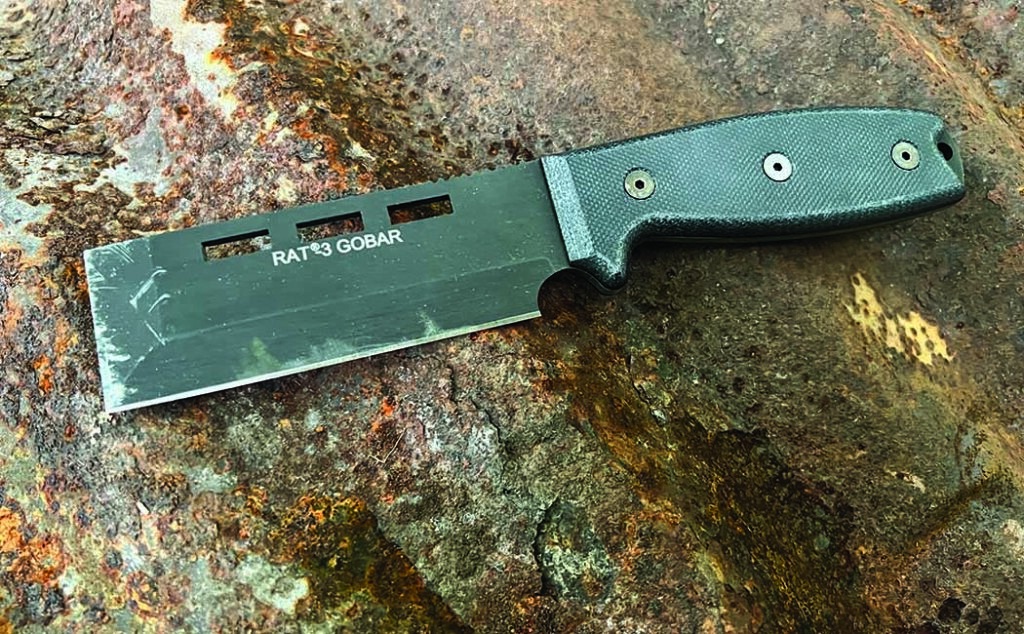
The Ontario RAT-3 Gobar is shaped like a 90-degree cleaver and functions for most knife tasks. The square-edge blade tip cannot be used for stabbing in the traditional sense and functions more along the lines of a fixed-blade box cutter. It has the ability to pry, though the blade material is relatively thin for any serious work. It can get under seat belts and cut them but is not ideal for the purpose.
It works in a pinch as a rescue tool and can be used to lever or jimmy windows and doors. It is not a tool I would baton with a mallet for fear of snapping off the blade. The cutout at the ricasso is too small to fit a finger into despite giving the appearance it should accept one. The corner of the edge recurves slightly backward, and if you get your finger in there like I did, you may get a nasty cut. A bonus is the tool is quite thin. It takes up little space and at only a few ounces is lightweight. The sheath is an afterthought. I would like to have seen this one come with a dedicated polymer model given that the one supplied is too long and features only a snap button to retain the blade.
Ontario Knife CO. RAT-3 Gobar Specs
Knife Type: Fixed blade/pry tool
Blade Material: Carbon steel
Blade Grind: Chisel
Handle Material: Black Micarta®
Special Features: Lightweight fixed blade can chop and do light prying
Weight: 5.8 ozs.
Overall Length: 7.8”
Sheath: Black nylon
Country of Origin: USA
MSRP: $91.95
Emerson N-SAR (Navy Search and Rescue)

The Emerson N-SAR (Navy Search and Rescue) is small and easy to store, and is also exceptionally durable and sharp in all the right places. This is a tool for cutting a person free safely. The blunt tip is not designed to stab. The blade is not impossible to cut with, it is simply unlikely you would stab through a person’s clothing when trying to free them. It zips through any type of common restraint. The main edge serrations can cut thicker material.
The blade opens one-handed or with the Emerson Wave feature when pulling it from a pocket. Care must be taken with the latter, as the dedicated belt cutter on the spine of the blade can become caught on a pocket accidentally and slice your clothing. I know this from experience. Though somewhat pricey for a knife that isn’t good for normal cutting chores, it is invaluable for extracting individuals from standard seat belts, child seats or any manner of physical restraints. The belt cutter can cut cable ties as well. I have begun leaving an N-SAR in an easy-to-reach place in my vehicle for cutting seat belts and straps in emergencies.

Emerson Knives, Inc. N-SAR Specs
Knife Type: Folding rescue
Blade Length: 3.5”
Blade Grind: Chisel
Edge: Plain and serrated combo
Blade Material: 154CM stainless
Handle Material: Black G-10/glass laminate
Pocket Clip: Yes
Lock: Linerlock
Special Stuff: Safety blade tip (blunted), Wave opening feature, integrated belt cutter
Weight: 4.1 ozs.
Closed Length: 4.7”
Country of Origin: USA
MSRP: $299.99
Read More On Survival And Rescue Tools And Knives:
- Best Survival Knife: These Blades Could Save Your Skin
- Last-Ditch Survival Kits
- Best Multi-Tools: Multitasker Marvels
- Best Bushcraft Knife: When Steel Meets The Woods
Best EDC Fixed Blade Knife: A Cut Above The Rest
These EDC Fixed Blade Knife Options All Have Their Positives As Everyday Companions.
Fixed blades are common in the woods though far less so on the streets—politics has largely seen to that. Folders are in the pockets of many these days and are somehow considered “less dangerous” than fixed blades.
I cannot for the life of me understand this as there is little if any practical difference in terms of capability, with the exception of fixed blades in theory allowing for a longer blade.
There is this idea that a fixed blade is more lethal. Sure, a longer blade allows for greater reach and penetration, but it’s also harder to use in close confines—and substantially more difficult to deploy.
EDC Fixed Blade Knife Pros And Cons
The argument against the carry of larger fixed blades is certainly political, not practical. It could be considered in the same vein as the political arguments surrounding guns, most of which are dedicated to regulating what amounts to cosmetic features. If it looks scary, the thinking goes, you can convince people it is more dangerous.
The interesting part is that the small EDC fixed blade knife options in this article are, for the most part, around the same size as box cutters. The thing is, when we see EDC, we often think about how the item is meant to be on your person, at the ready for utility jobs and even self-protection if need be. The latter is more the case with guns, where there are no power settings, only a fully lethal one.
In my stories on guns, I have often talked about how accessory-laden modern self-defense arms can be, but at the end of the day you’re not going to open your FedEx deliveries with a gun. Self-defense is a major purpose of firearms, whereas your EDC knife should be a jack-of-all-trades and capable of handling all your daily cutting tasks.
In the process of preparing this article, I had the pleasure of moving into a new house. As such I got to put the test blades through their paces, cutting everything from tape and cardboard to zip ties—and even dinner when I couldn’t find my silverware. In place of my carving knife I used the White River M1 Caper to serve chicken dinner.
The point is, these are supposed to be knives that benefit from fixed-blade construction, able to handle tasks that might damage a folder.
Best EDC Fixed Blade Knife Options
Fixed EDC Fixed Blade Knife Specs Comparision
| Model | Overall Length | Blade Length | Blade Thickness | Weight | Blade Material | Handle Material | MSRP |
| Boker Pocket Knife | 6.93 inches | 3.39 inches | 0.15 inches | 3.74 ounces | 440C | G10 | $105 |
| White River Knife & Tool’s Model 1 Caper | 7 inches | 3 inches | .130 inch | 3.2 ounces | CPM S35VN or CPM Magnacut | Micarta | $120 |
| Citadel Vannak V | 5.75 inches | 2.38 inches | .72 inch | 2.9 ounces | DNH7 | Palisander Wood | $175 |
| Gerber Dibs | 5.96 inches | 2.5 inches | .12 inch | 2.22 ounces | 440A | 440A | $36 |
| Kizlyar Supreme Hammy | 6 inches | 2.13 inches | .13 inch | 3.6 ounces | AUS-8, Niolox, Sleipner, K340, PGK | walnut, G10 or carbon | $117 |
| Boker BFF | 6.92 inches | 2.76 inches | .10 inch | 2.29 ounces | ABE-L | Walnut | $259 |
| Spartan Blades Field Grade Enyo | 6.25 inches | 2.69 inches | .19 inch | 2.816 ounces | AUS-8A | AUS-8A | $88 |
Boker Pocket Knife

Boker has quite the little devil with the Pocket Knife. The name, of course, implies that it is to be carried in the pocket, and it comes with a sheath that works very well in this role. It’s the longest blade in the group but has the smallest handle.
The handle size is deceptive; it is very minimalist in the pocket and the sheath sits low, thus making the knife appear to have a much smaller blade. It carries well and is lightweight—two things I like. However, in use, it becomes a bit more of a challenge.
I do get that the Pocket Knife, designed by veteran knifemaker and police officer Mickey Yurco, has a self-defense vibe. The EDC fixed blade knife’s long, narrow tip is an obvious thruster, though the overall texture of the full piece is very slick. The handle shape forces the hand into a slightly uncomfortable angle. Sheathing the knife is also difficult if clipped deep in a pocket.
As a regular-use knife, I have seen better. That said, in a self-defense role, this would be the best of the bunch. If the blade is in your hand in the reverse grip, it feels solid and firm. The tang cutout between the choil and the handle is perfect for pinky finger placement in the reverse grip, and the knife is an effective stabber and slasher in tight spaces.
This is an excellent blade to pair with grappling techniques and for dealing with heavy clothing. All said, I like what Boker did here. It is a knife that goes in your pocket, but I don’t think it is well suited for the role of a traditional pocketknife.
Pocket Knife Specs
Overall Length: 6.93 inches
Blade Length: 3.39 inches
Blade Thickness: 0.15 inches
Weight: 3.74 ounces
Blade Material: 440C
Handle Material: G10
MSRP: $105
White River Knife & Tool’s Model 1 Caper

White River Knife & Tool’s Model 1 Caper was the best performer of the reviewed EDC fixed blade knife bunch. I have come to expect great knives from White River, not just ergonomically but also in terms of the quality of steel the company uses. The blades are heat treated very well, are not brittle, and stay extremely sharp even in heavy use.
The first thing I noticed about this knife is the grip, which is not only minimal but very comfortable. I can tell White River spends a great deal of time on the small things, such as the tang cutout having a very nice rounded interior edge that feels great on the finger and never digs into it. The grip material and shape feel terrific in the hand. The only downside is the Micarta® handle gets dirty fast and can stain.
The sheath is very well constructed and allows for positive sheathing with an audible click when the knife is seated. The sheath is meant for belt carry and is not a clip style like the others in the test, and fits most standard belts. The sheath surprised me a bit; it was the easiest to use of the bunch.
As far as utility for a carry knife, this one is probably the most versatile of the group. It is extremely sharp and has an aggressive, fine tip. It is so sharp it can pass through just about any normal material easily. I used it to cut heavy packaging straps and minutes later to prepare dinner. This is the definition of an all-purpose knife.
Model 1 Caper Specs
Overall Length: 7 inches
Blade Length: 3 inches
Blade Thickness: .130 inch
Weight: 3.2 ounces
Blade Material: CPM S35VN or CPM Magnacut
Handle Material: Micarta
MSRP: $120
Citadel Vannak V
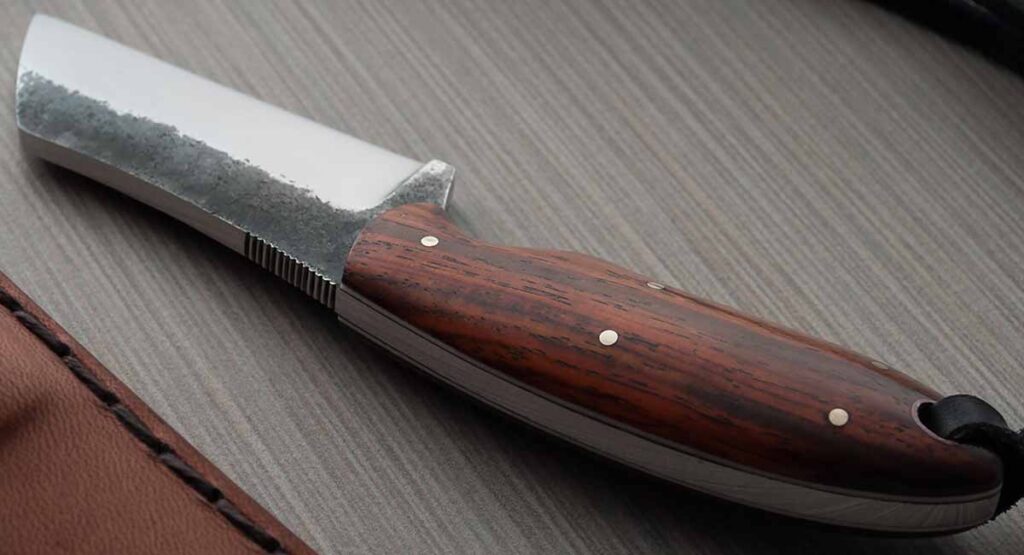
Made in Cambodia by Citadel, the Vannak V is an excellent EDC fixed blade knife. Overall, I really like this little guy. It doesn’t claim to be anything other than a daily use, small-task cutter. It’s great for opening mail and packages, light food prep, and small craft work. It is very pleasant to use and has an exceptional appearance.
Despite it being a great performer, I don’t have a tremendous amount to say about the Vannak V. It is devoid of gimmicks and is just a very tiny knife that does no more than its size allows. I like the wood grip and that the knife is made by hand by people who obviously care about what they’re doing.
The fit and finish are great. I have no complaints about grip texture or the depth of the tang cutout as the knife can’t really be used in the reverse grip—it’s just too small. The sheath is leather, minimalist, and completely functional.
Vannak V Specs
Overall Length: 5.75 inches
Blade Length: 2.38 inches
Blade Thickness: .72 inch
Weight: 2.9 ounces
Blade Material: DNH7
Handle Material: Palisander Wood
MSRP: $175
Gerber Dibs
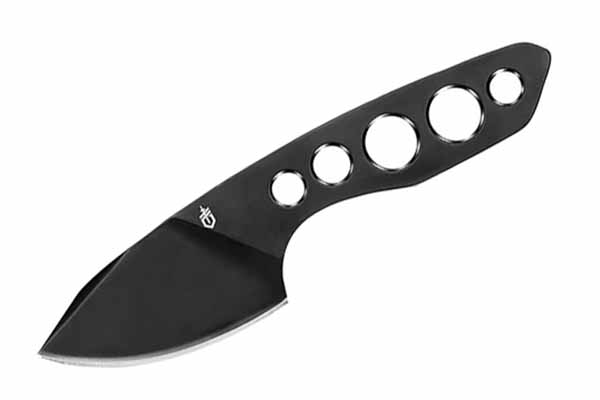
The Gerber Dibs is a one-piece, skeletonized-handle knife common among small examples of the genre. The 440A stainless steel blade is 2.5 inches and has a modified clip point. A flat grind gives the edge plenty of bite for tough cutting chores.
The ergonomic handle has a large finger recess that doubles as an integral guard. When you grab the handle, it expands a bit to fill your grip. In addition to reducing overall weight, the skeletonized holes accommodate a paracord wrap to further augment purchase.
An all-encompassing black PVD coating provides a low-profile appearance and enhanced corrosion resistance. Overall length is just shy of 6 inches, making the Dibs a great compact knife for general use or food prep.
Out of the box the edge was excellent, ready to work and featuring plenty of bite. It dispatched cardboard with minimal fuss. The edge quality along with the dropped blade design help promote overall knife security, using either a choke grip for precise maneuvers or resting a thumb on the blade spine to add more control or pressure for the cut.
With skeletonized fixed blades, it is important to have a more complex handle design with varying features to help you retain your grip in the absence of scales. Despite having no scales, the Dibs is quite comfortable to grip. Skeletonized fixed blades are not meant for long periods of continuous use and are for convenience of carry instead. Bottom line, the knife is a pleasure to use.
The sheath is sewn-and-riveted leather dyed yellow. At first it appears too big—which it probably is—for such a small knife, but sheathed the Dibs is advertised as totable inside the pocket as well, which explains the large design.
If you have cargo pants with larger front pockets, it carries very well there. A button-snap strap secures the knife and a large loop accommodates most belt sizes. The sheath’s edges are rough and not finished too well. Then again, Gerber targets affordability and as much bang for the buck as possible with the Dibs, so corners apparently were cut.
Gerber Dips Specs
Overall Length: 5.96 inches
Blade Length: 2.5 inches
Blade Thickness: .12 inch
Weight: 2.22 ounces
Blade Material: 440A
Handle Material: 440A
MSRP: $36
Kizlyar Supreme Hammy
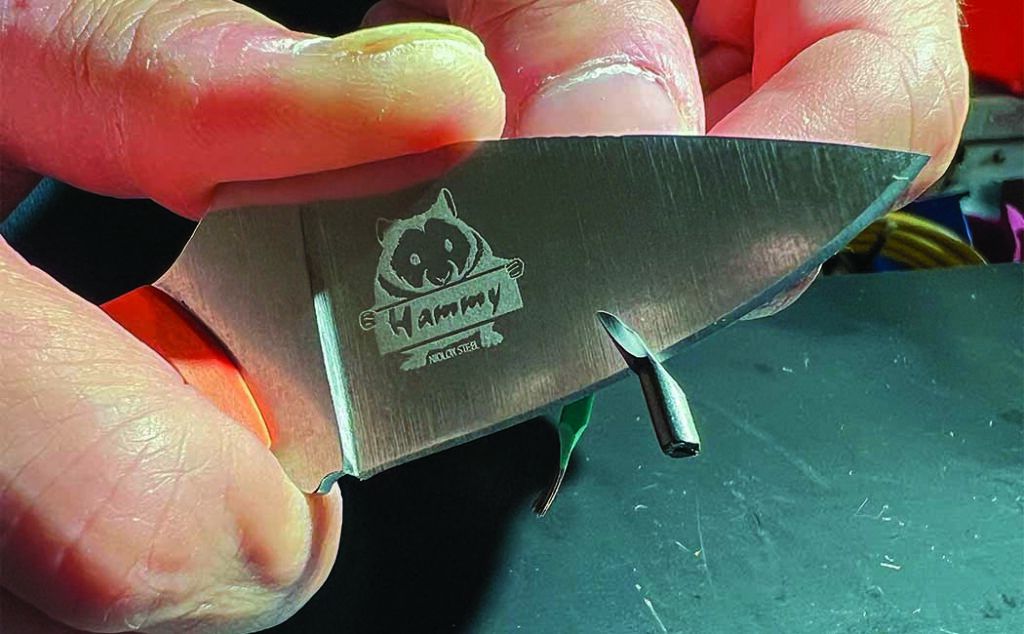
The Kizlyar Supreme Hammy is an incredibly ergonomic knife. The leaf-shaped blade is 2.1 inches long and sports a full flat grind for slicing power. Blade steel is Niolox stainless. The highly ergonomic handle is loaded with curves that feel molded for your hand. Orange G-10 scales provide a pop of color and a solid grip. The handle is expertly chamfered and contoured in the right places, further enhancing user comfort.
At first glance the Hammy appears cute—but don’t let looks fool you, as it’s designed and built for work. It’s a fixed blade the size of a small open folder. The blade is .11 inches thick at its thickest point and sports a distal taper to the tip. Jimping on the blade spine and thumb rest offer non-slip purchase for your thumb or index finger.
When you grip the handle and your thumb rests naturally on the blade spine, you feel how comfortable the Hammy is. You can also sense the knife is highly controllable, instilling user confidence. The jimping could be a little better. It could be more defined/aggressive to offer a better bite into your thumb.
The leather sheath has a button-snap retention strap. There are also two smaller belt loops attached to the main belt loop. These are provided to carry the Hammy horizontally, as it is set up for traditional vertical carry like most straight knives.
While the sheath itself is well made and includes a whimsical artwork stamping of a hamster (the same illustration appears as an etching on the blade’s right-hand side), it doesn’t have the snuggest fit around the knife. Even with the retention strap buttoned it is possible to still wiggle the Hammy out. This is not so critical if you carry the Hammy vertically, but it is a concern if you carry it horizontally. A properly fitted sheath at this price point is a must.
Supreme Hammy Specs
Overall Length: 6 inches
Blade Length: 2.13 inches
Blade Thickness: .13 inch
Weight: 3.6 ounces
Blade Material: AUS-8, Niolox, Sleipner, K340, PGK
Handle Material: walnut, G10 or carbon
MSRP: $117
Boker BFF

The Boker BFF fixed blade designed by Lucas Burnley is ultra-compact for discreet, comfortable carry. Its design cues are taken from the barlow pocketknife, a general go-to cutting tool for centuries. The 2.7-inch blade is AEB-L stainless steel in a clip-point shape that is very utility friendly. The blade has an acid-wash finish to hide scratches.
At 6 inches overall, the compact fixed blade almost disappears on your side. The handle comes in a choice of walnut or a more practical green canvas Micarta®. The Micarta is contoured nicely, making the handle rest in your hand snugly. The brass rivets and thong tube provide a nice visual contrast. The knife’s beauty lies in its simplicity of design and execution. It proves that no bells and whistles are needed for a cutter to be highly functional.
The sheath is a nicely made leather pouch style with a slight symmetrical taper toward the bottom. The iconic Boker tree logo is stamped into the leather. A sturdy steel pocket clip enables the BFF sheath to attach to or be removed from your belt quickly—no muss, no fuss.
With such a lightweight knife, a big belt loop would be overkill. The knife fits the sheath like a glove, with no rattling or wiggling. The sheath compresses down on the handle to hold it securely inside. When the knife is sheathed, the handle sticks up about an inch, plenty for you to grab onto. It also has a hole for a lanyard.
BFF Specs
Overall Length: 6.92 inches
Blade Length: 2.76 inches
Blade Thickness: .10 inch
Weight: 2.29 ounces
Blade Material: ABE-L
Handle Material: Walnut
MSRP: $259
Spartan Blades Field Grade Enyo
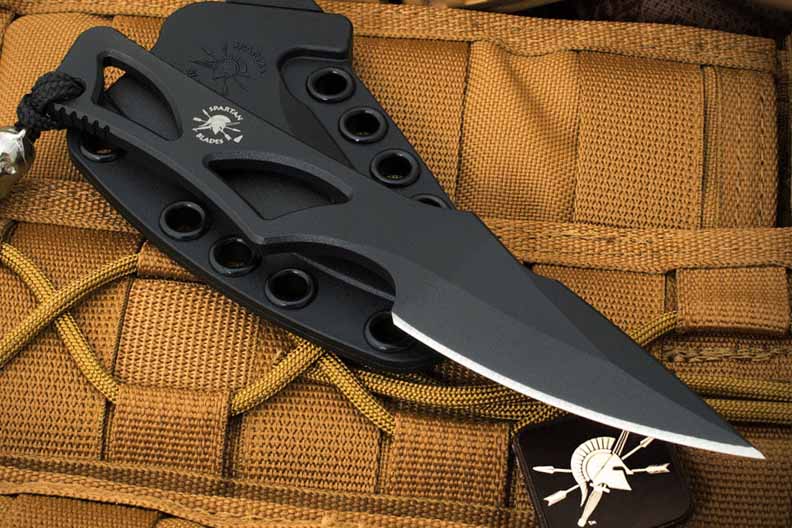
The Field Grade Enyo is a staple of the Spartan Blades line. It boasts an easily concealed blade designed for either utility or backup personal protection. It shares the same dimensions as its higher-priced sibling in CPM S45VN stainless steel, the Enyo, with the exception that the blade steel is AUS-8 stainless.
The modified clip point blade is 2.68 inches and the knife is 6.25 inches overall. The skeletonized one-piece design simplifies the knife and makes it easy to carry. The handle accommodates two different hand holds, which aids in increasing the knife’s versatility.
Several areas of jimping assist in getting a good non-slip grip. A black epoxy coating throughout provides a low-profile appearance. A paracord lanyard includes a polished Spartan helmet bead, which is pretty neat.
In action the Field Grade Enyo is all business. Don’t mistake it for a small, cute knife. It has attitude and packs a punch! The blade tip is reinforced a bit due to the false edge and penetrates fairly well. Thanks to the way the blade profile tapers, the tip cuts easily. The flat grind and superb edge quality out of the box enable the knife to handle business immediately.
The handle’s various curves seat your hand snug and solidly. The two-thumb rest provides the option of choking up further on the blade for a more reliable grip and improved control. It’s amazing such a small, compact fixed blade can feel so trustworthy in the hand.
When you tackle larger cutting chores, you can choke up on the handle to stabilize the knife and feel in charge at all times. The lack of handle scales means the knife is the bare minimum in bulk.
Those who say they do not like skeletonized knives might want to reconsider with the Field Grade Enyo. You’ll find yourself using it more and more. AUS-8 is well known in the industry for being a good, mid-grade steel, balancing edge holding and economy. It certainly doesn’t disappoint here. It is an excellent choice of steel for a knife of its price point.
The sheath is form-fitting molded plastic riveted for strength. One of the best things about the sheath is how well it locks the knife inside. There is a ramped, notched thumb button on the opening end that when pushed up releases a lock so the knife can exit the sheath. When sheathing the knife you will hear a tiny click indicating the lock has engaged. No amount of tugging on the handle or violent shaking of the sheath upside down can cause the knife to fall out.
This is very well done and a feature not commonly seen, not only on knives of this price class but more expensive ones, too. Included is a belt loop for IWB (inside waistband) carry, as well as a length of paracord for neck carry. The two carry choices promote both discreteness and ease of access.
Field Grade Enyo Specs
Overall Length: 6.25 inches
Blade Length: 2.69 inches
Blade Thickness: .19 inch
Weight: 2.816 ounces
Blade Material: AUS-8A
Handle Material: AUS-8A
MSRP: $88
Editor’s Note: Dexter Ewing contributed to this piece.
Read More
- Shaving Sharp
- Smokin’ Cutters
- Return Of The Tactical Fixed Blade


